[Mild spoilers.]
From a certain point of view, the 70-year-old Timely/Atlas/Marvel superhero Captain America is tailor-made for the movies. After all, he has relatively down-to-earth abilities (much like Batman, his abilities have been increased to the peak of human perfection; but he does not have Superman-like physics-defying abilities); his adventures are filled with swashbuckling derring-do; and he has that patriotic thing going. No wonder that he has been depicted on the large and small screen in no less than five movies: A 1940s serial; two TV-movies in the 1970s; a feature film in the mid-1980s that was never officially released; and the current CAPTAIN AMERICA: THE FIRST AVENGER. (That doesn't count EASY RIDER, with a main character named after Cap.)
One might then wonder why the superhero film craze of the last decade has taken so long to showcase the Star-Spangled Avenger; or why Marvel itself released the CA movie after other licensing studios passed on the character. There are several reasons. Perhaps the most significant is the clout that foreign markets carry today -- foreign markets that might be less than enthused with a hero who wears red, white and blue and calls himself America. Further, Cap's brand of genial patriotism has gone in and out of style in the American cinema. Further, the previous movie adaptations of Captain America have been less than thrilling.
CAPTAIN AMERICA: THE FIRST AVENGER therefore has a lot to live up to. Fortunately, the Joe Johnston-directed feature strikes the right note, in several ways: The retro-futuristic look, which includes many tributes to original Captain America artists Joe Simon and Jack Kirby, as well as the death-ray tech of 1940s science fiction; the sweeping Alan Silvestri score; action scenes that recall the rough-and-tumble of Kirby's Cap stories, both those from the '40's and those from Cap's revival in the '60's (just as in the comics, anyone Cap socks goes flying across the room); Cap's weapon, his shield, which he carooms off targets and back into his hand like a billiard-ball frisbee; and the inclusion of another Jack Kirby creation (with Stan Lee), the Howling Commandos (with their multi-ethnicity diversity increased to appeal to international audiences); Chris Evans' earnest and nuanced portrayal of Cap; Hugo Weaving's Red Skull, who would twirl a mustache if he could grow one on his excoriated face); and the ending to the movie, a terrific bridge between the 1940s and the present that pays homage to the comic book story while avoiding some of its absurdities.
The movie did sound some wrong notes with me, however:
-- In what appears to be an attempt to avoid ticking off international audiences, Cap and the Howling Commandos battle Hydra, depicted here as a renegade branch of the Nazis, rather than the Nazis themselves: There is hardly a swastika in sight. This lessens the significance of Cap's symbolic battle against the Nazis themselves and all that they stood for.
-- The U.S. Government's initial repurposing of Cap as a USO performer selling savings bonds is a witty commentary on how the armed forces often misused the talents of their personnel. But if the USO is going to put Cap into a costume and have him perform, why not take advantage of his physical abilities and have him perform some acrobatics? (One of Stan Lee's best Daredevil stories from the '60's involved DD going to Vietnam and performing acrobatics for the troops. A similar scene here would have made good cinema.)
-- I understand the filmmakers' decision to create a more practical field outfit for Cap. But I do wish that they hadn't created such an awful, comic-relief version of his original uniform for the USO scenes. Simon and Kirby's Captain America costume is an inspired visual creation; it deserves some respect.
-- Finally, I found the 3-D incredibly distracting. Although the scene with the shield flying toward the viewer was quite effective, the effects tended to undermine the action scenes, by focusing the viewer's (this viewer's, at least) eye on the wrong elements.
But overall, the movie deserves the accolades it has received. Marvel Studios is developing a Pixar-like record of solid movies that has likely made its initial investors happy -- and must certainly be pleasing its current owner, Disney, happy.
Bring on THE AVENGERS.
The scattershot musings of a Los Angeles appellate attorney and devotee of popular culture
Sunday, July 31, 2011
Comic-Con 2011: Post Mortem
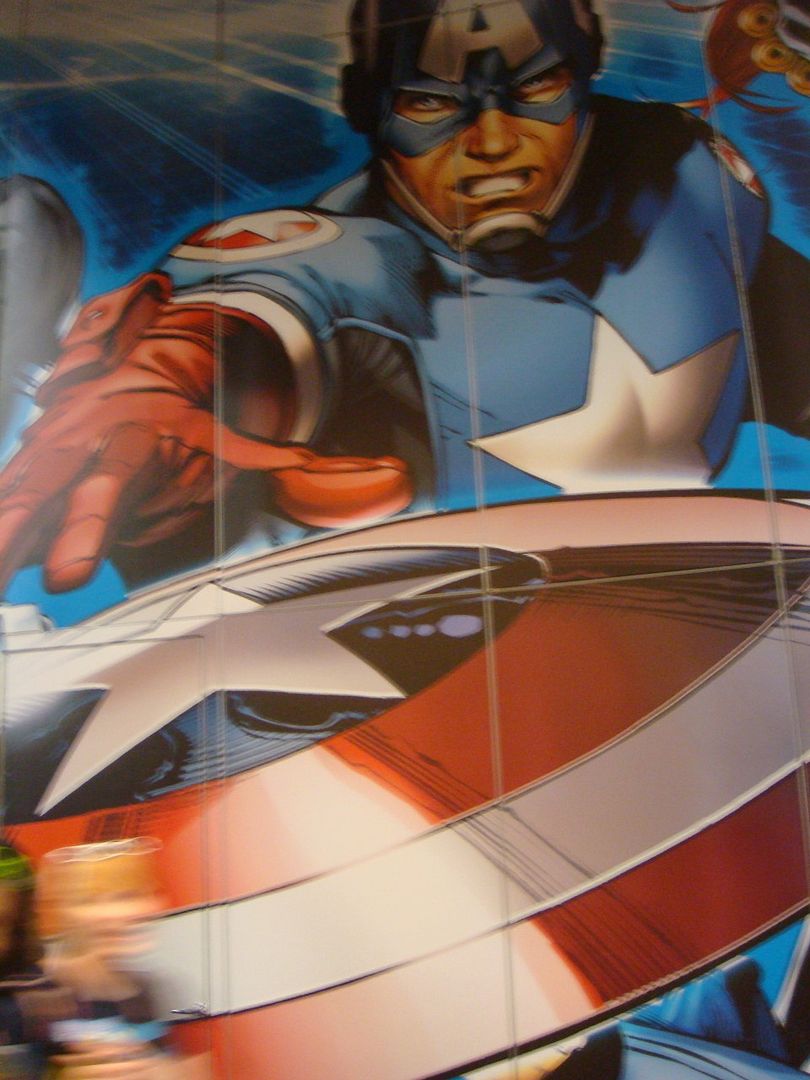
The two constants at Comic-Con International: San Diego -- much as in comics themselves -- are continuity and change. Sometimes, the two go hand in hand. For instance, at this year's Comic-Con, I commissioned a sketch from Wendy Pini, from whom I commissioned a sketch at my first Comic-Con, 31 years ago. And considering the passage of decades, the price wasn't much different: $40 now, compared to $10 then. But while for years convention sketches have been paid for in cash, or on occasion by check, I paid for this one (and several other purchases in the Dealer's Room) by credit card, signing my name with my fingertip on Richard Pini's iPhone. These two themes of continuity to past conventions, and changes, played themselves out over and over during the four-and-a-quarter-day con.
Along with the Pinis, many creators I met or saw at the con three decades ago can still be seen there. Folks like Marv Wolfman, Len Wein, Mark Evanier (who hosted a baker's dozen panels, as he has for years), my old friend Phil Yeh (whom I first met at a Seattle convention nearly 30 years ago), Brent Anderson, and others still come to the con to meet their fans and talk about their craft.
Many changes related to the Con's swell of popularity in recent years, fueled by its reputation as a source of word-of-mouth promotion for the superhero movies and other film and TV projects that relate to Comic-Con's pop culture sensabilities. For instance, for years Amy and I have purchased our memberships for the following year's convention onsite. In the past, this involved walking up to a table in the main lobby, perhaps waiting in a line one or two people long, and picking up the memberships. Last year was a bit more complicated: We bought the memberships on the last day of the Con, and because the Preview Night passes were being sold only at the convention (and because memberships started selling out a few years ago, for the first time), the line was fairly long. This year, the process of getting the next year's membership devolved into madness. The passes to be sold at the convention were apportioned between each day; and on each day the passes were sold only between 8 a.m. and 10 a.m. Those who lined up before the sun came out were able to buy 4-day passes with the Preview Night, at an unprecedented price of $175 each. We got into line shortly after 7 a.m. on the second day of the con; waited nearly four hours; and were still unable to get either the Preview Night feature or four-day passes. Instead, we got four one-day passes each.
Eventually, the sheer effort necessary to obtain memberships will likely cut down on the number of memberships sold, resolving the problem. Or the con may expand -- although it already fills the convention center and slops over to the two closest hotels.
Major movie studios' participation in the con also changed. Disney/Marvel and Warner Brothers/DC made headlines by declining to put on presentations for their upcoming comics-related films, leading to commentary that Comic-Con might be losing its buzz as a tastemaker.
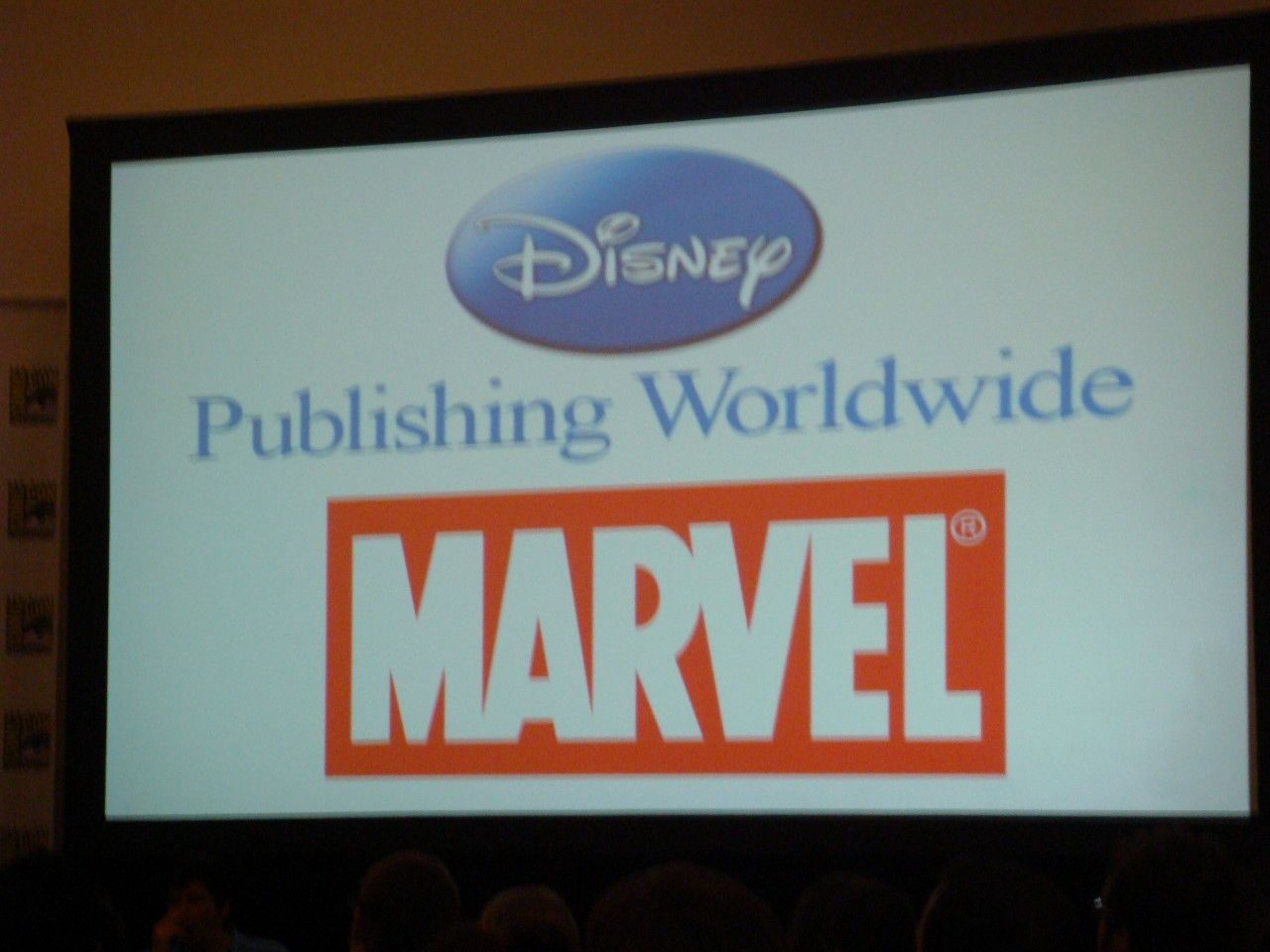
We held on to some hope that this trend would allow us to actually attend some of the movie and TV presentations we had been unable to see for the last few cons, since they required lining up for so long that we'd miss a major portion of the convention if we tried to attend them. But unfortunately, we did not get into Hall H, or (for the first time) Ballroom 20, the mecca for TV programming. The closest we came to media panels was to attend the highly-entertaining panel put on by Penn & Teller to advertise their upcoming TV show on Discovery. (To do so, we sat through a mildly-interesting panel on Voltron.)

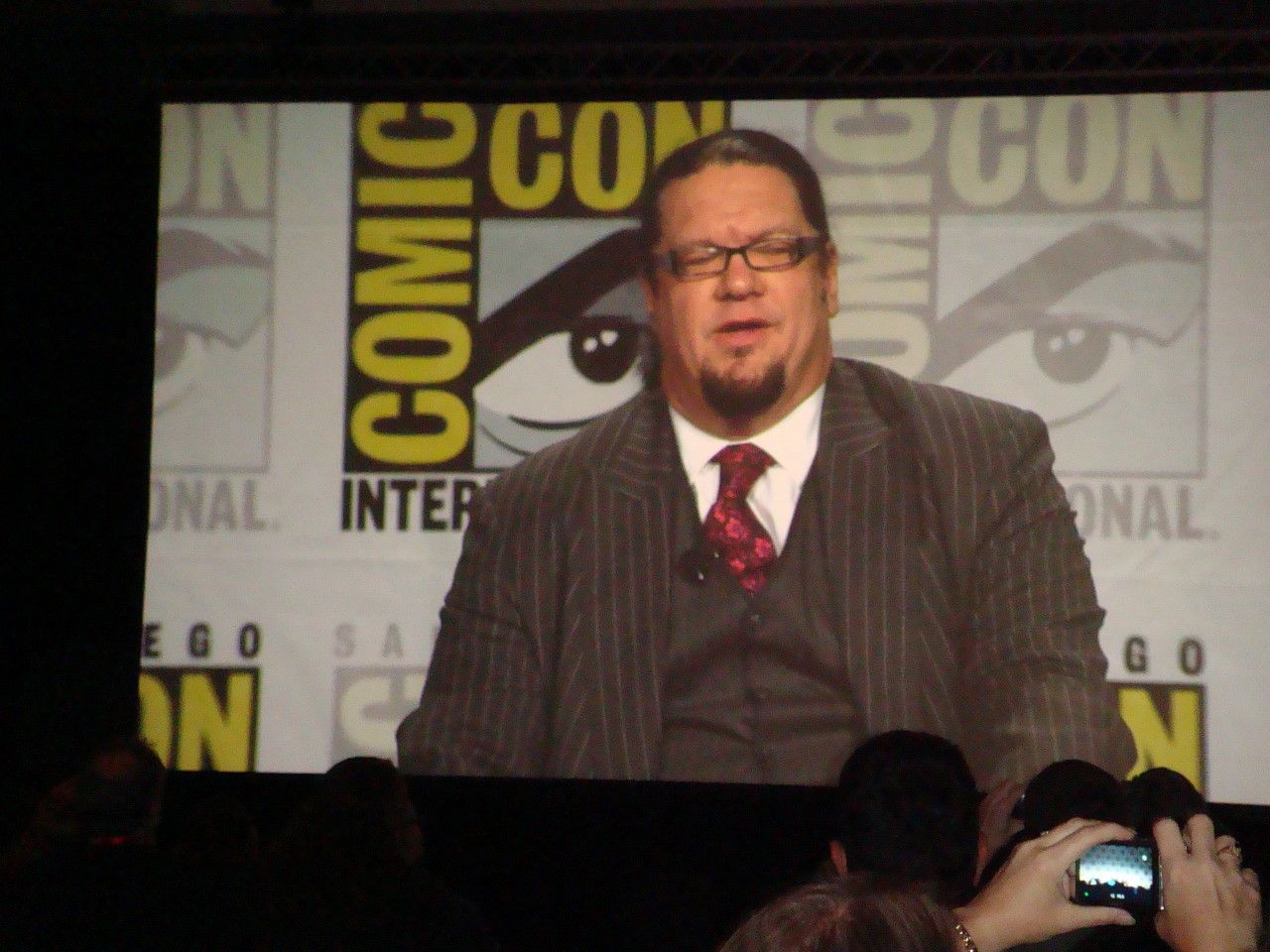
Further, Marvel did not abandon the con entirely. Notably, they premiered CAPTAIN AMERICA: THE FIRST AVENGER at a nearby theater, a day before it opened nationwide, leading to lots of goodwill from con goers (particularly in response to the trailer after the opening credits for next year's highly-anticipated AVENGERS movie.
And Marvel tricked out its booth in the Dealers' Room with a stunning recreation of SHIELD headquarters from the Avengers movie, complete with models in SHIELD jumpsuits:
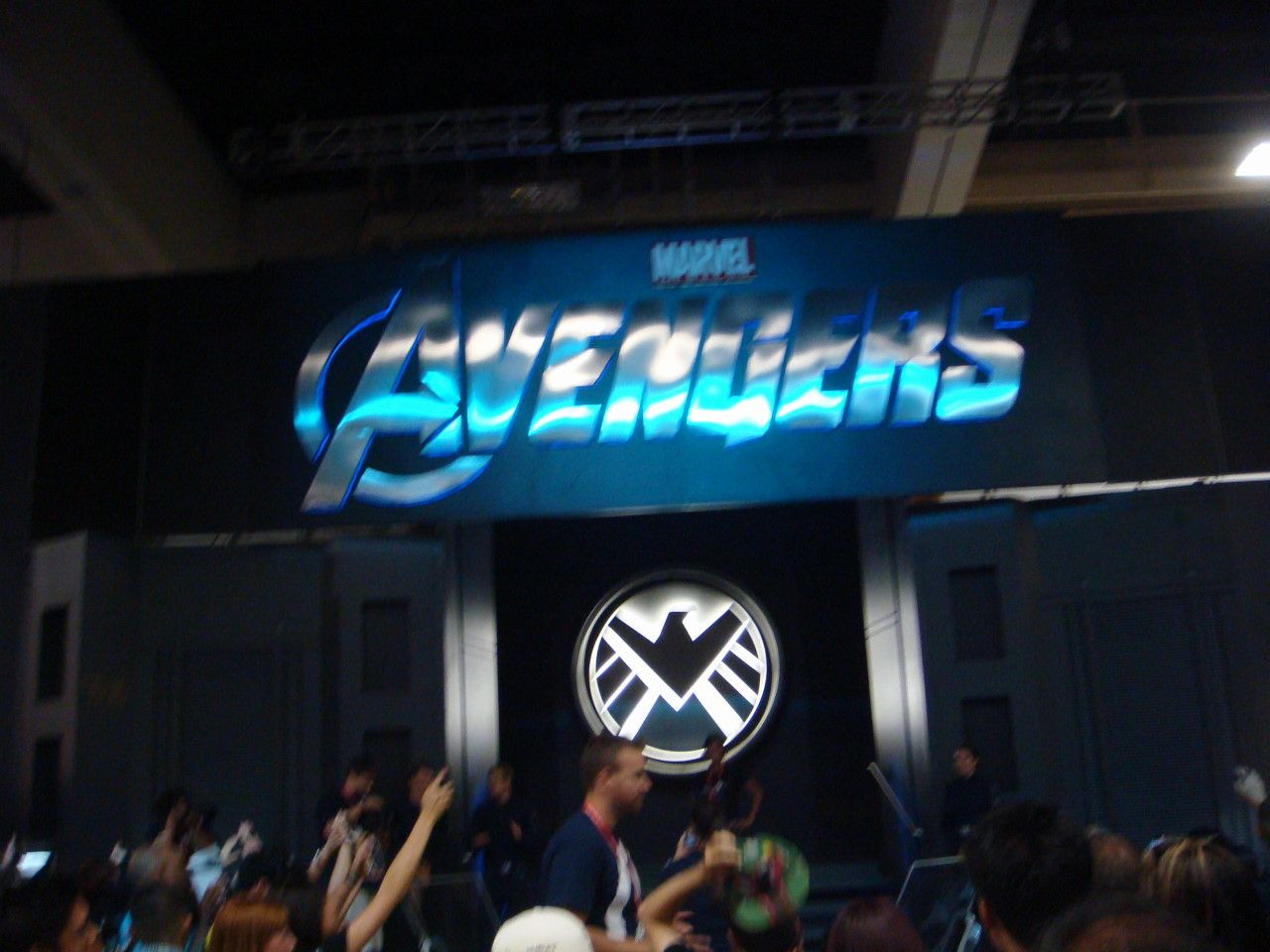

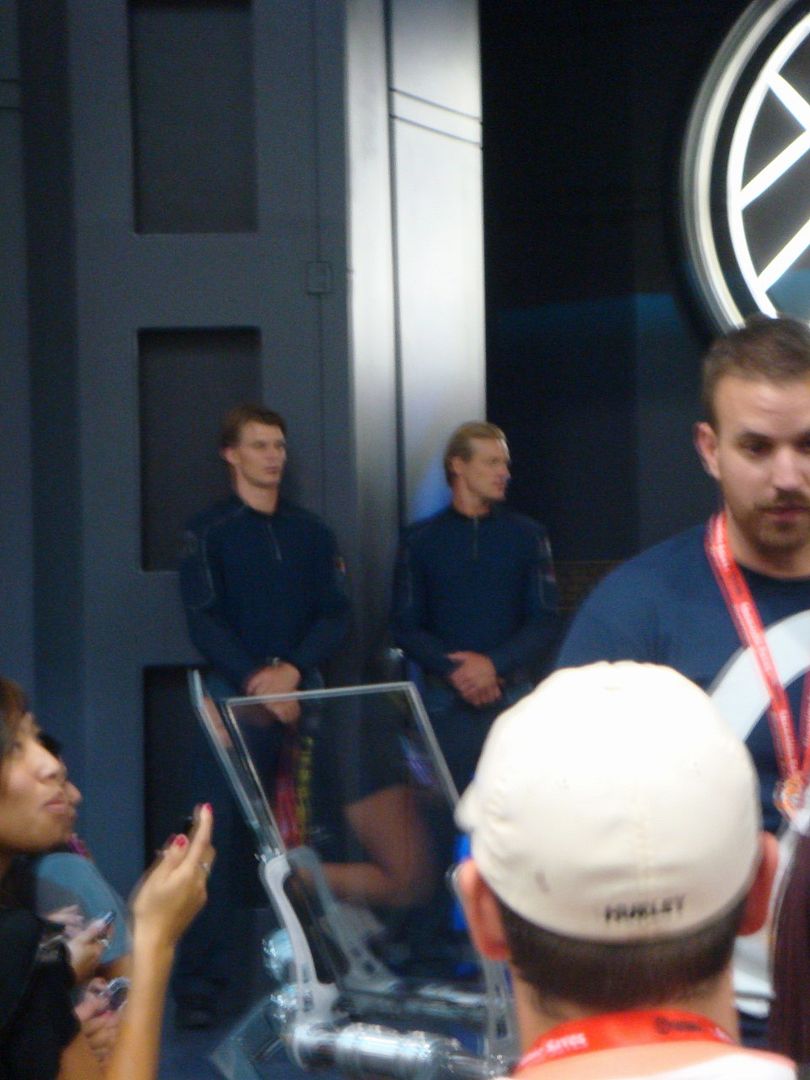
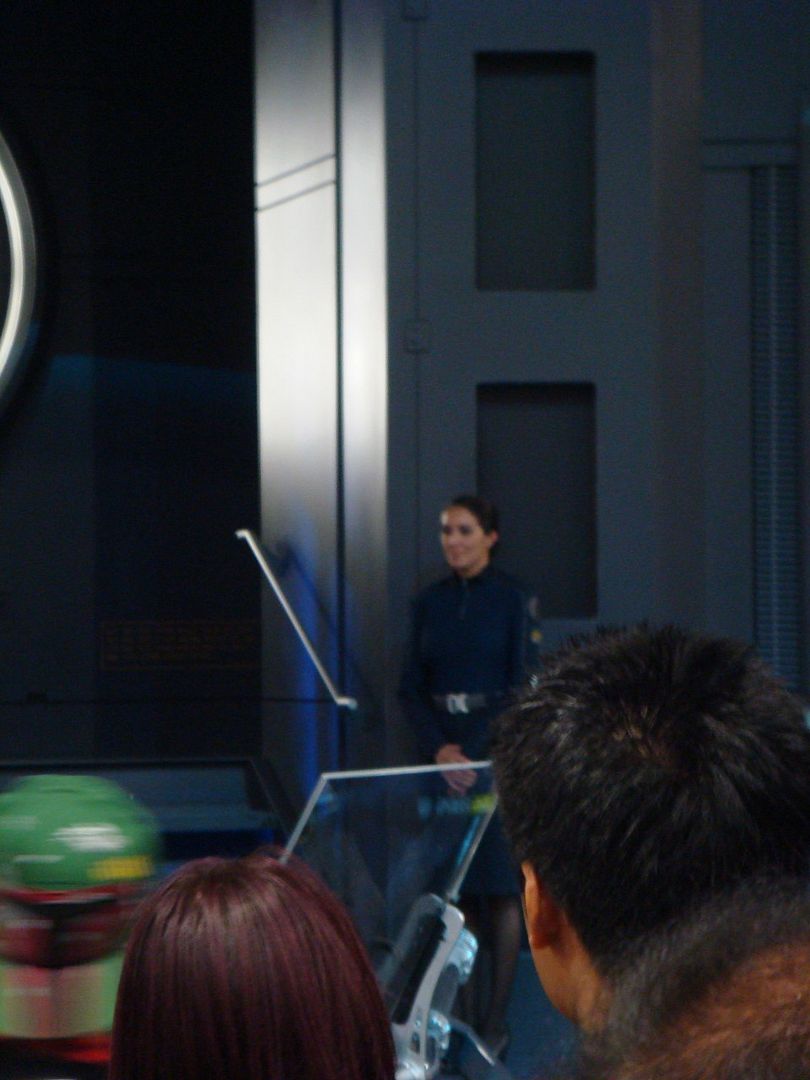
And DC Comics was certainly represented at the con, with T-Shirts and con bags emblazoned with Jim Lee's redesign of the Justice League, and high-rises decked out with supergraphics advertising the upcoming Batman video game, Arkham City.
But what I really come to Comic-Con for are the comic-book creators, and the panels on which they talk about their pasts and future.
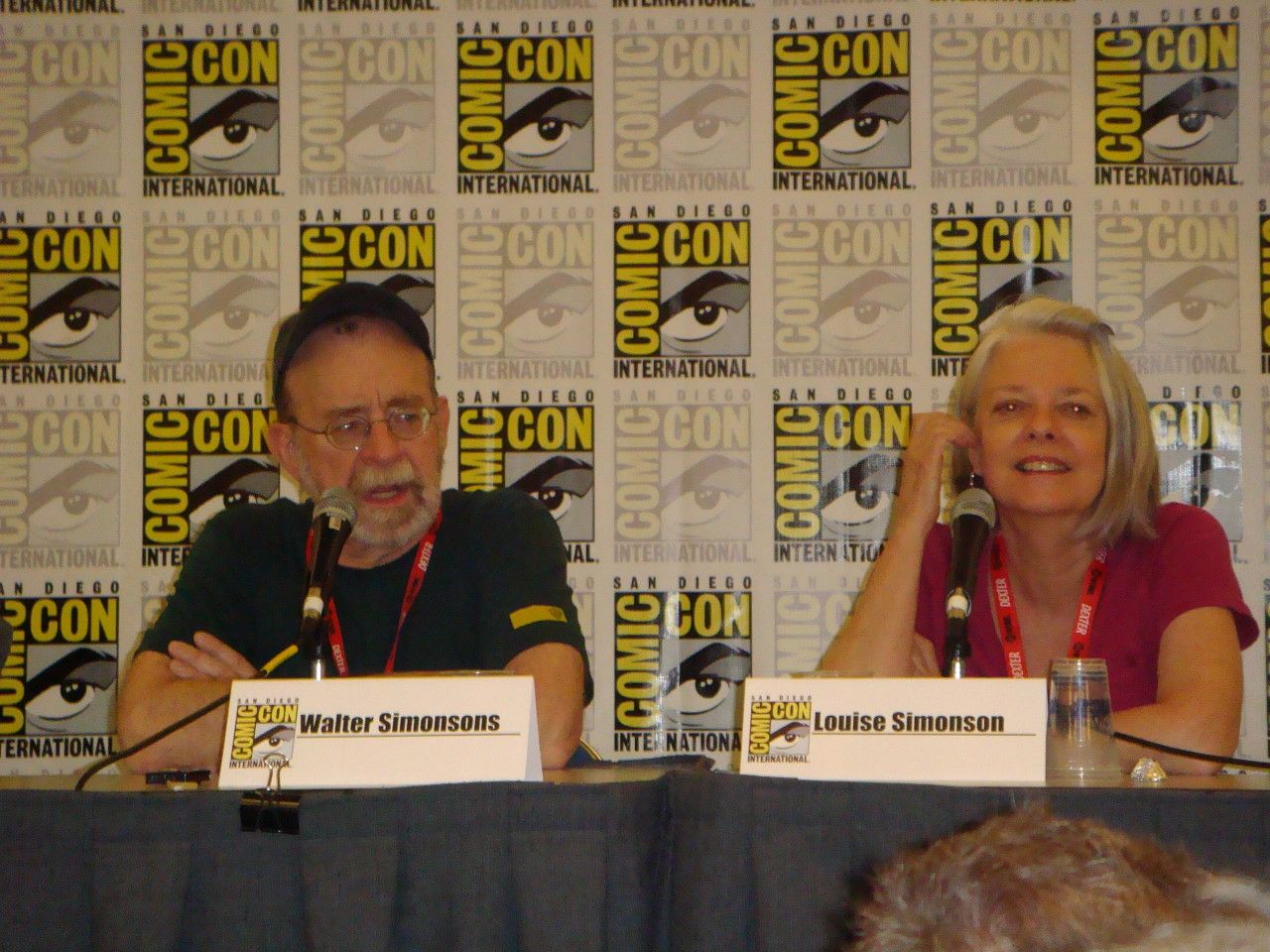
Indeed, since by Friday afternoon I had not attended any comics panels (having spent most of Thursday attending the Captain America screening, and Friday morning in the hideous pre-reg line for 2012), immediatly upon finishing the pre-reg and getting lunch at one of the handy food trucks a couple of blocks away, I insisted on sitting through three comics-oriented panels in a row: A tribute to the multi-decade career of the recently-deceased artist Gene Colan; a discussion of the comics fanzines of the 1960s; and the '70's panel, a tribute to the somewhat-staid, somewhat-experimental comics of that period. Interestingly, one of the con guests of honor, Roy Thomas, was on each of those panels.
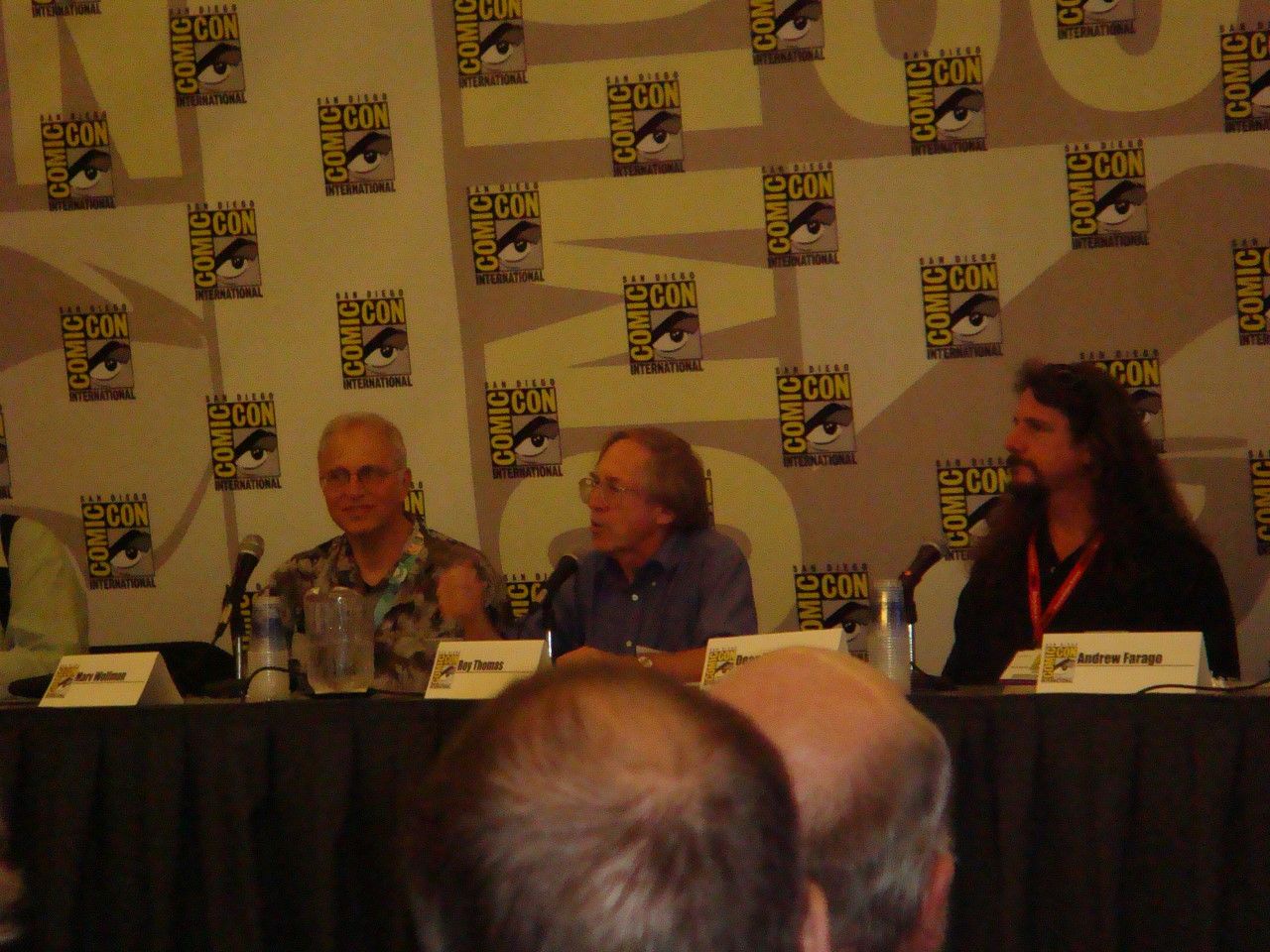
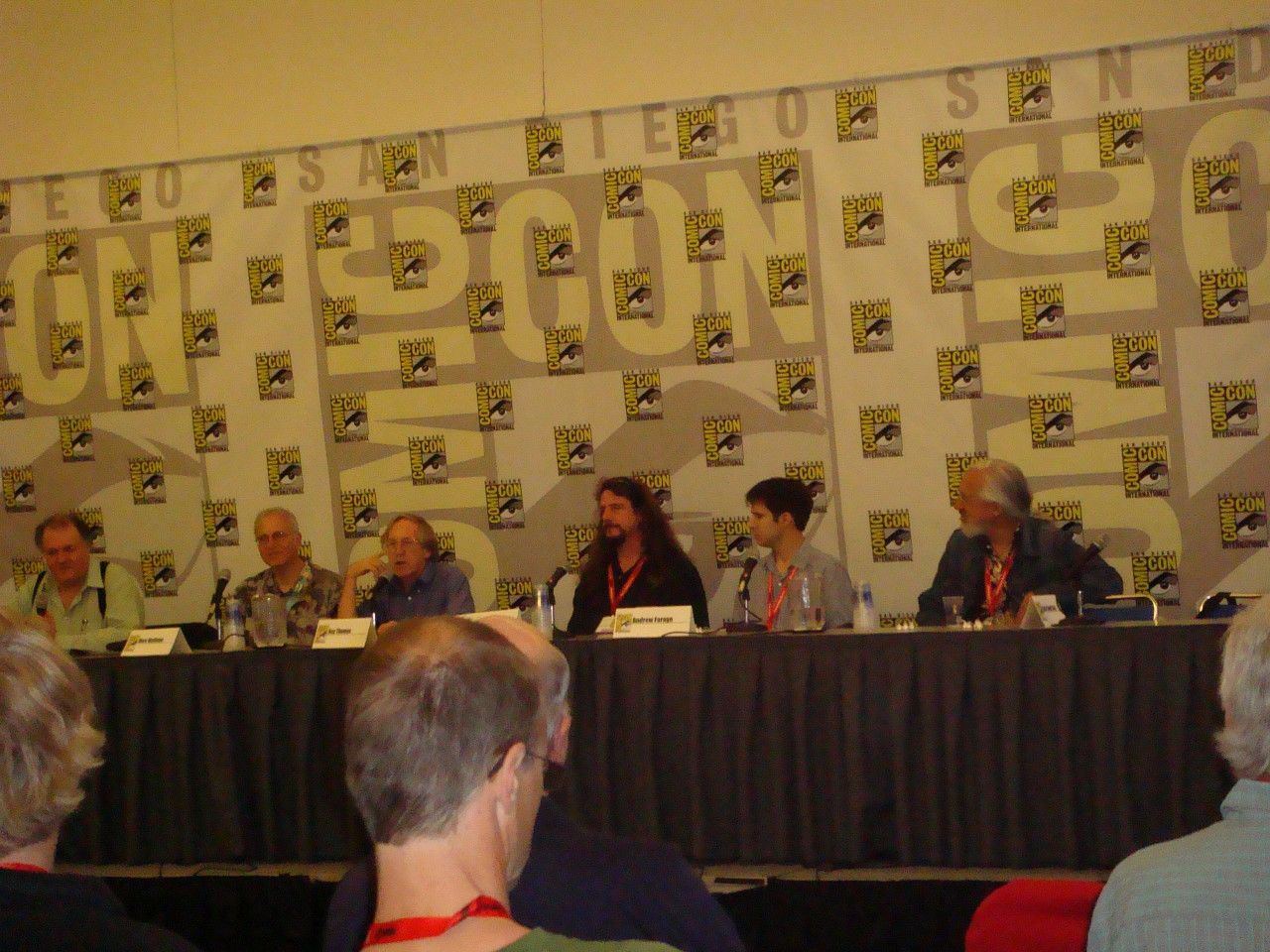


Saturday, as in previous years, was steampunk day. The steampunk panel was put in a much larger room than in previous years, yet filled up completely -- showing that interest in the subculture is not waning. And that afternoon, we once again had a big steampunk gathering on the mezzanine of the convention center, filled with amazing outfits and gadgets.
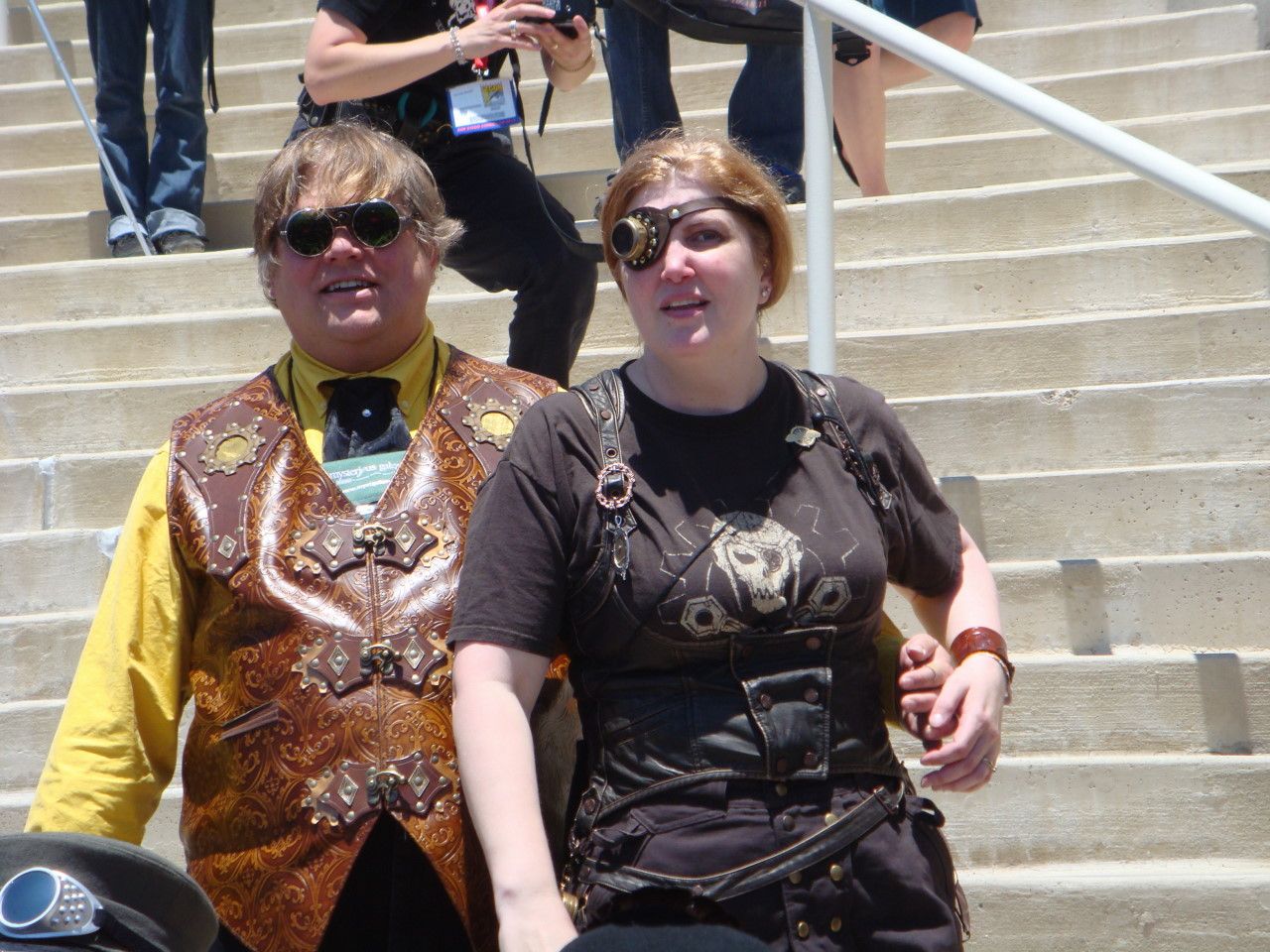
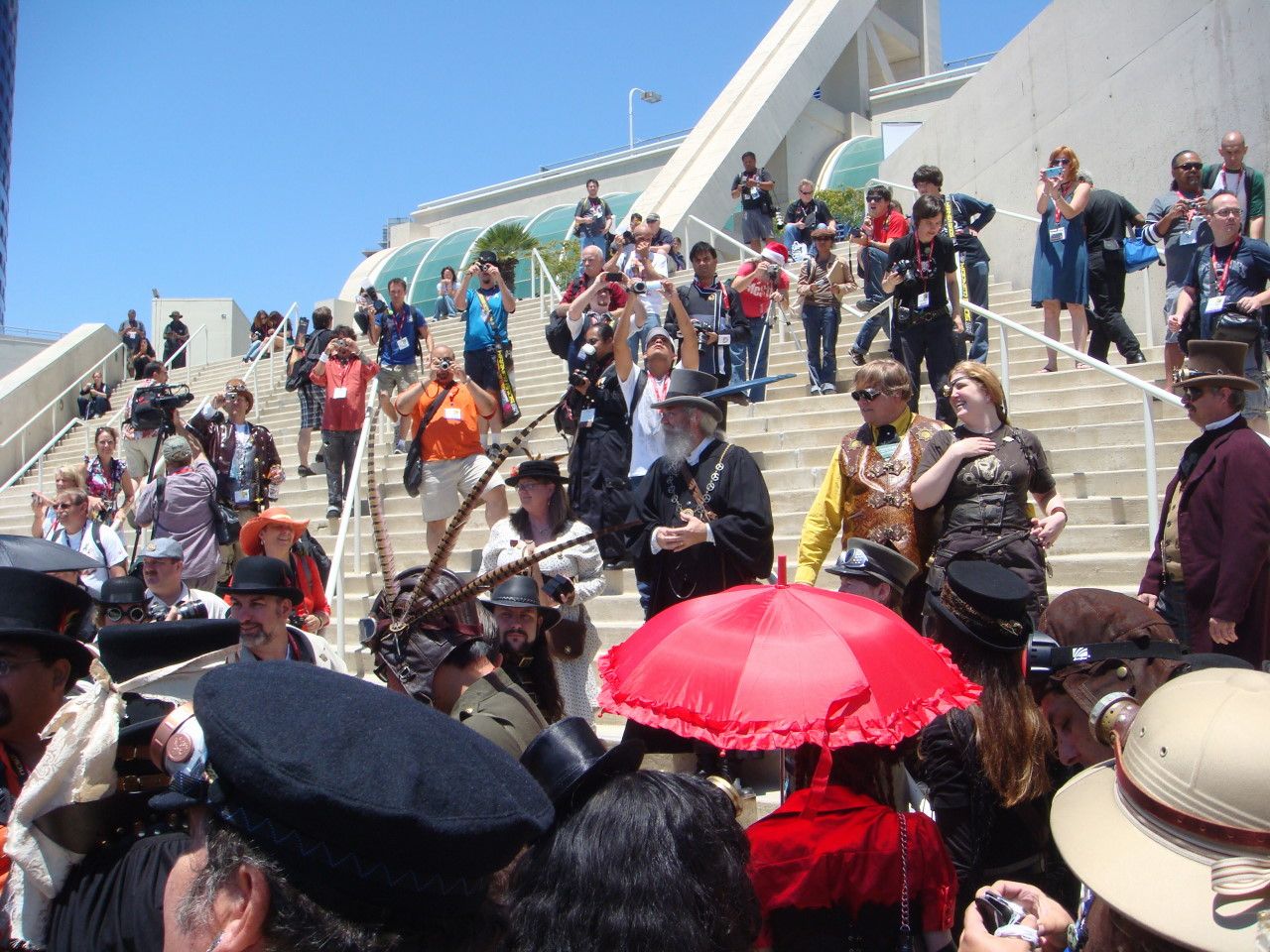
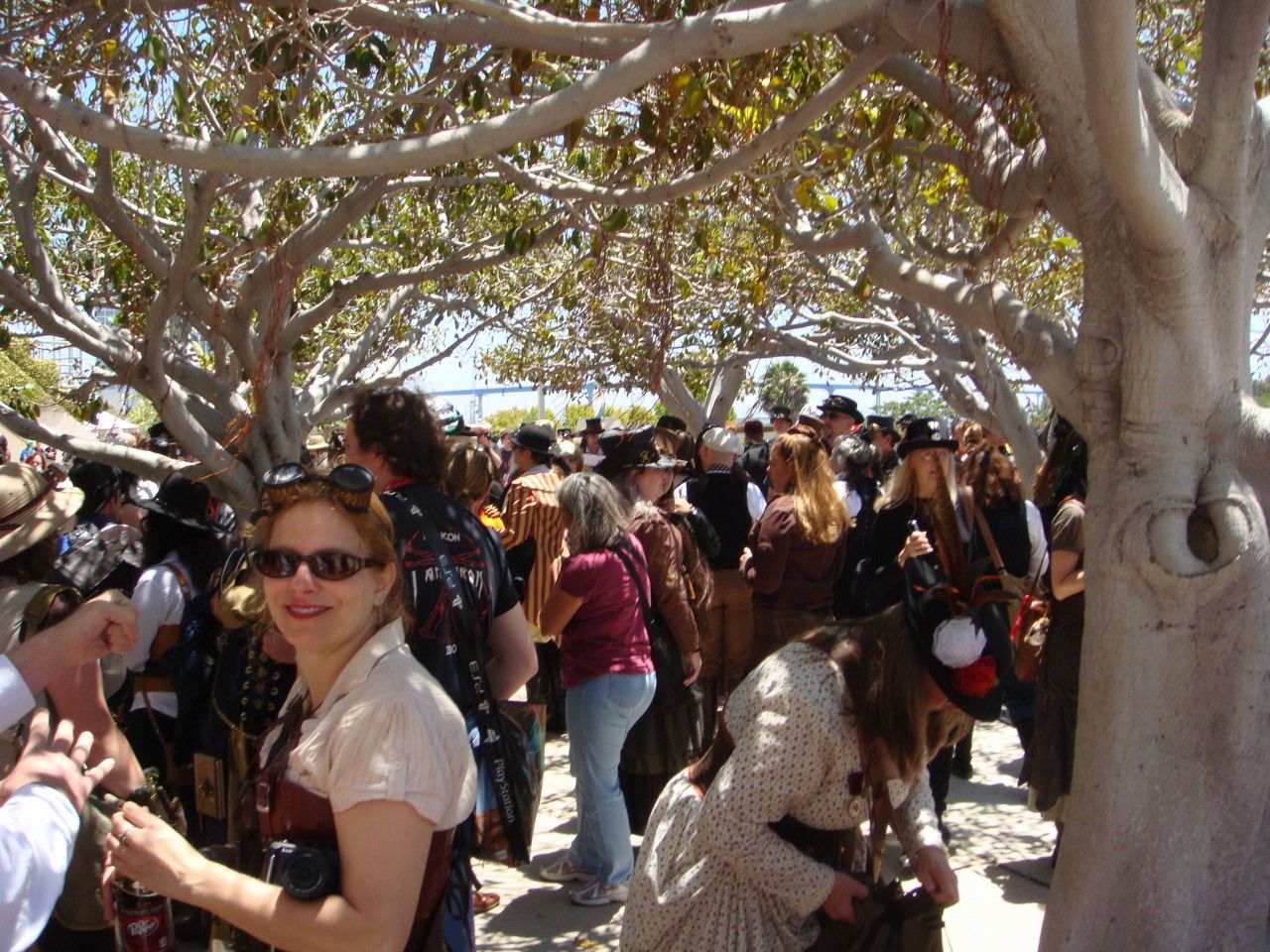


We finished out Saturday watching the masquerade -- not watching it live, nor at the party under the sails on top of the center, but in yet another ballroom where it was being simulcast. I suspect that between the three venues, everyone who wanted to see the masquerade had a chance to do so.
Sunday is generally our day for packing up, attending a few final panels, and doing a last sweep of the Dealers' Room. This customarily includes visits to the booths of Comic Relief and Bud Plant. But there again, change was in store. Comic Relief of Berkeley went out of business last year. And Bud Plant, after 41 years selling comics and art books, is retiring and selling his business. We went to his (much diminished) table, bought some books and chatted with Mr. Plant, but the atmosphere around his table was filled with the sensation of time passing.
We will be coming back to Comic-Con next year. (After what we went through to get passes for next year, we'd damn well better.) And we'll probably have a good time, like we did this year. But we'll probably be aware next year, as we were this year, that you can never go back to a Comic-Con you went to in the past, because, for better or worse, Comic-Con must always change.
Here are some parting miscellaneous photos of the con. More next year.


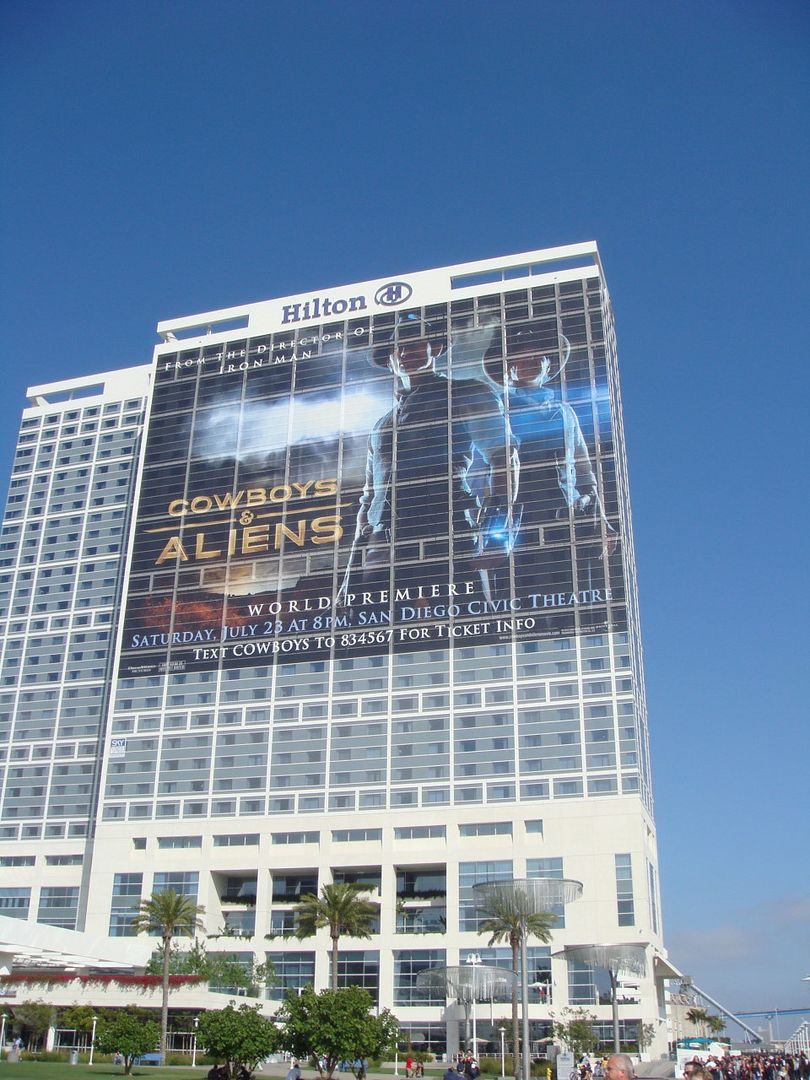
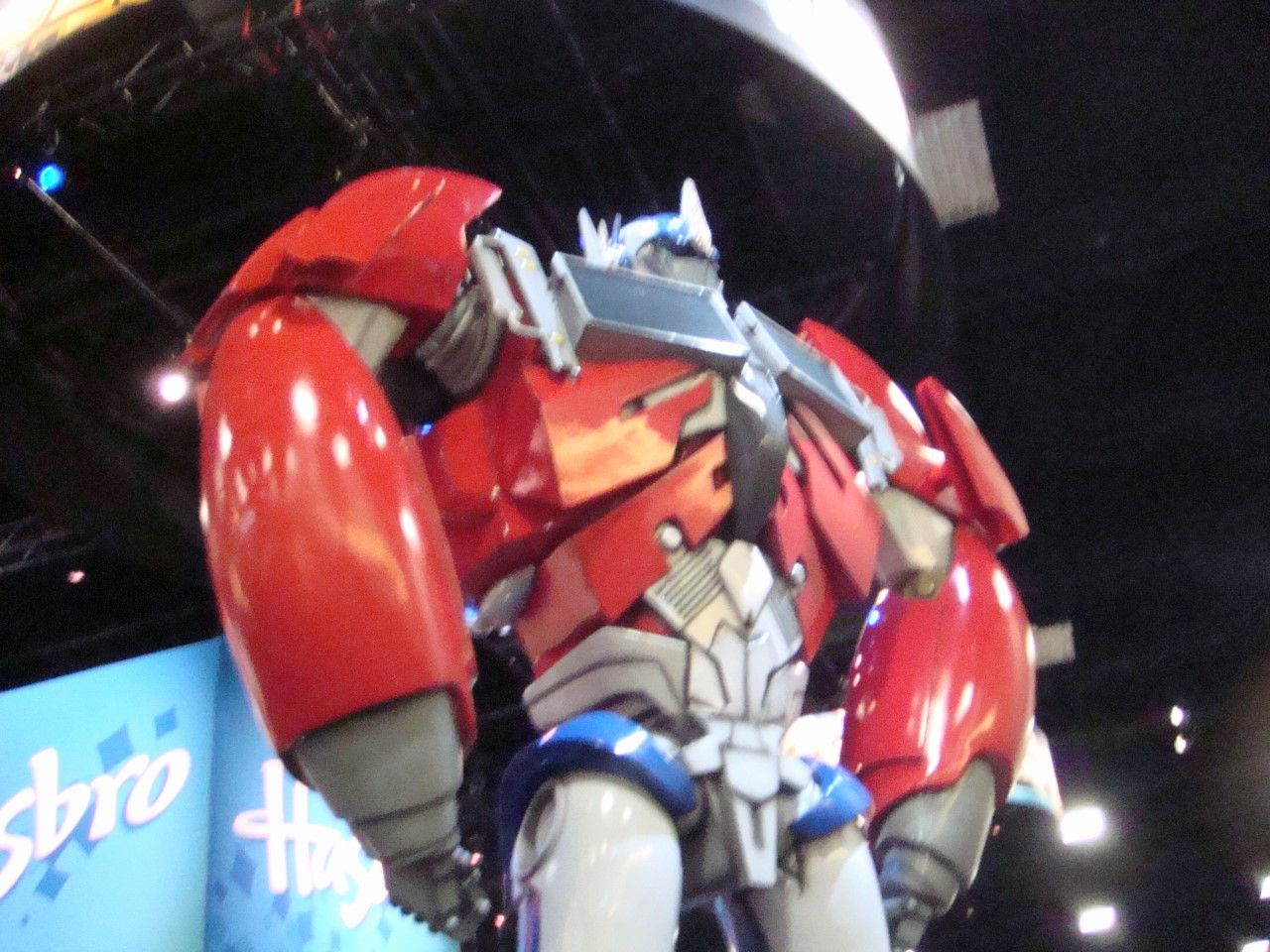
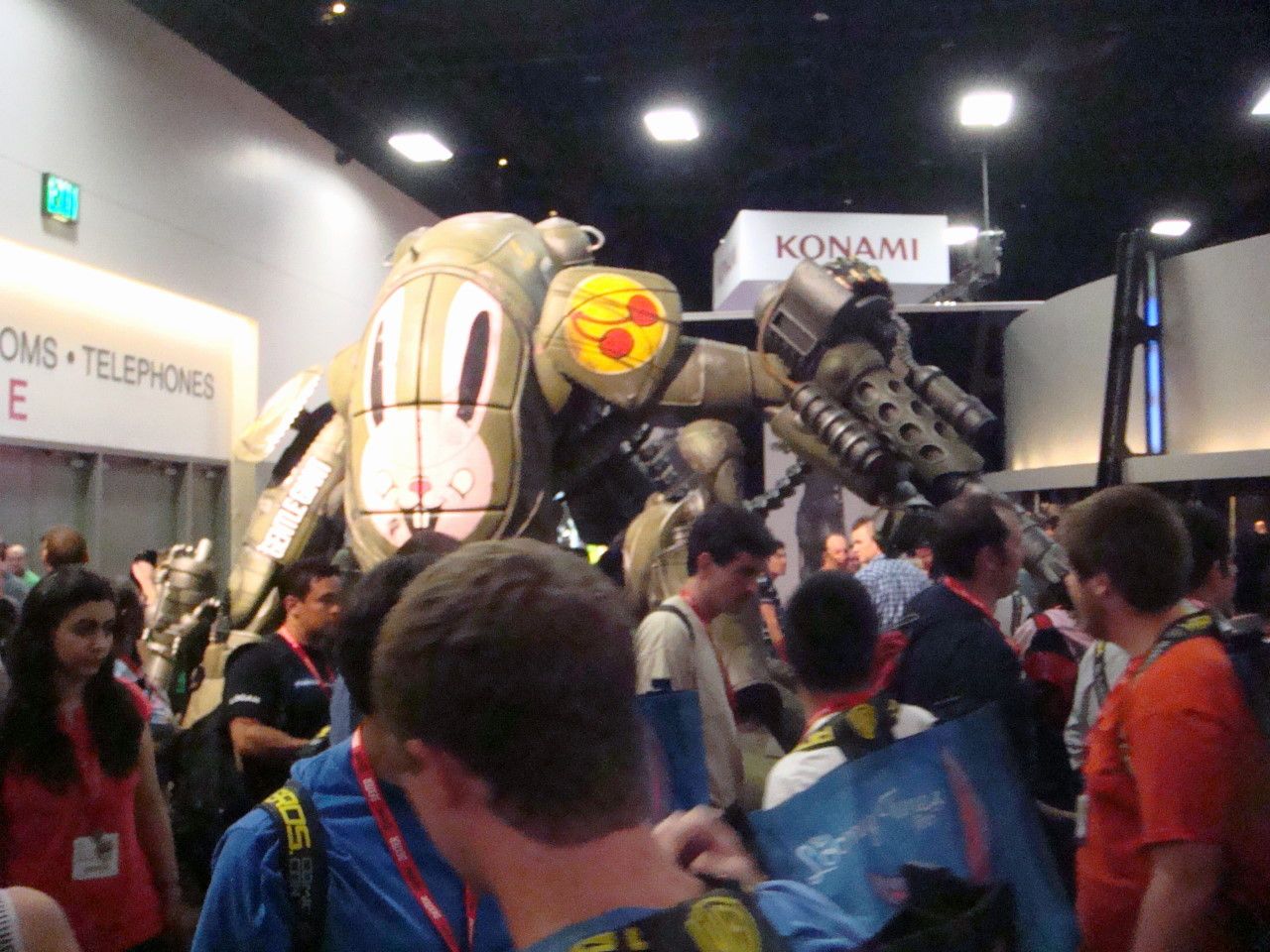
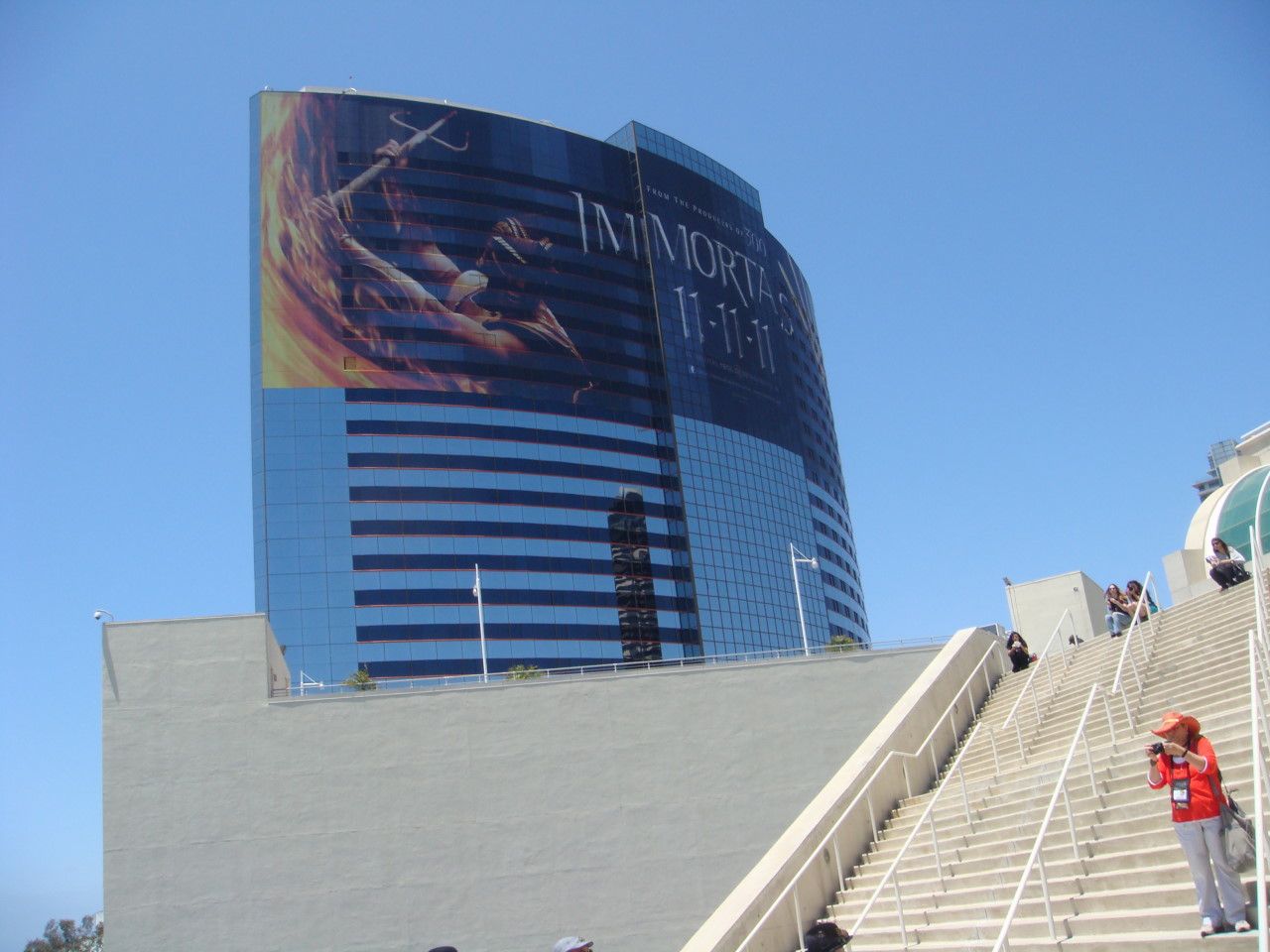
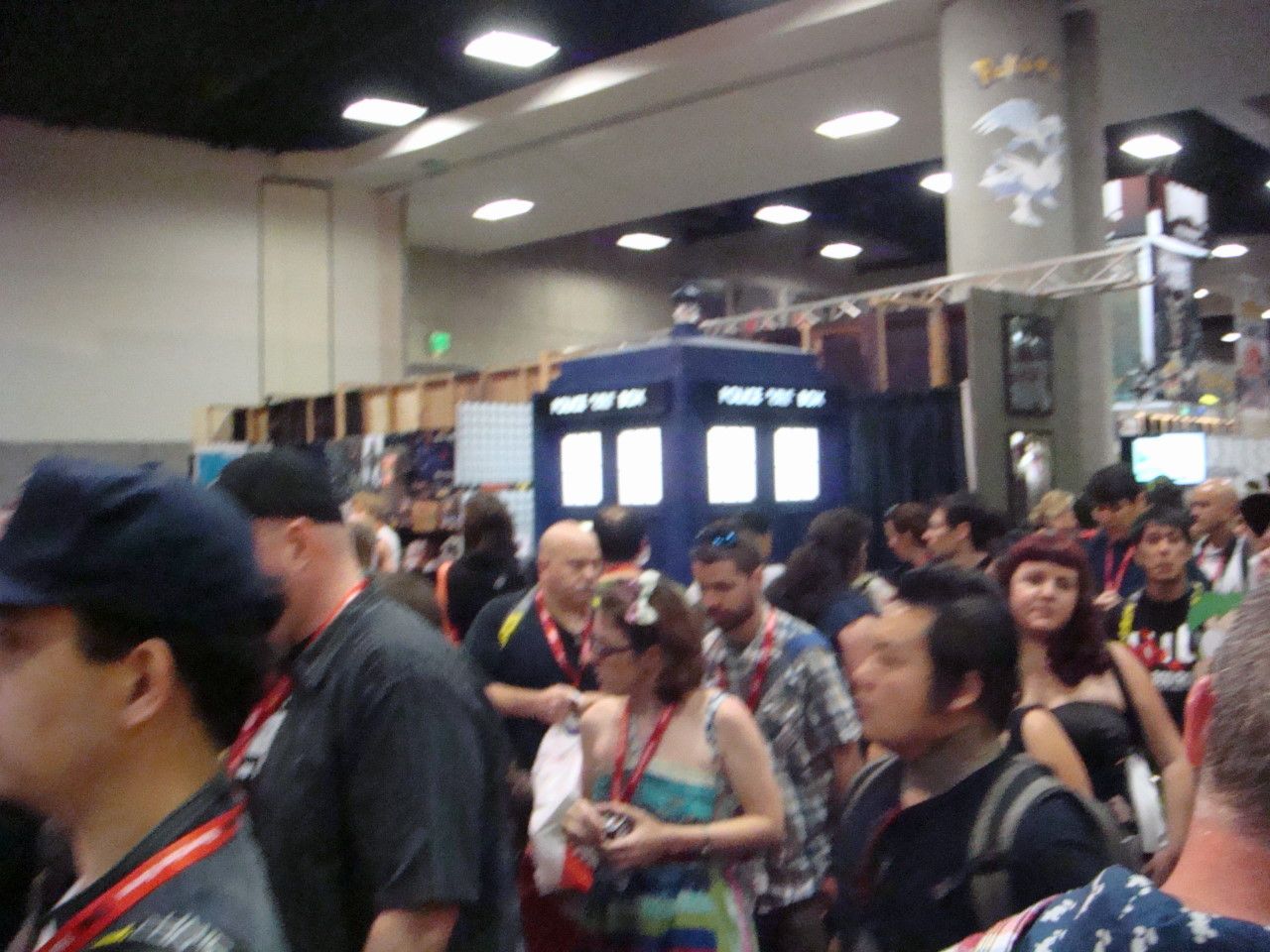
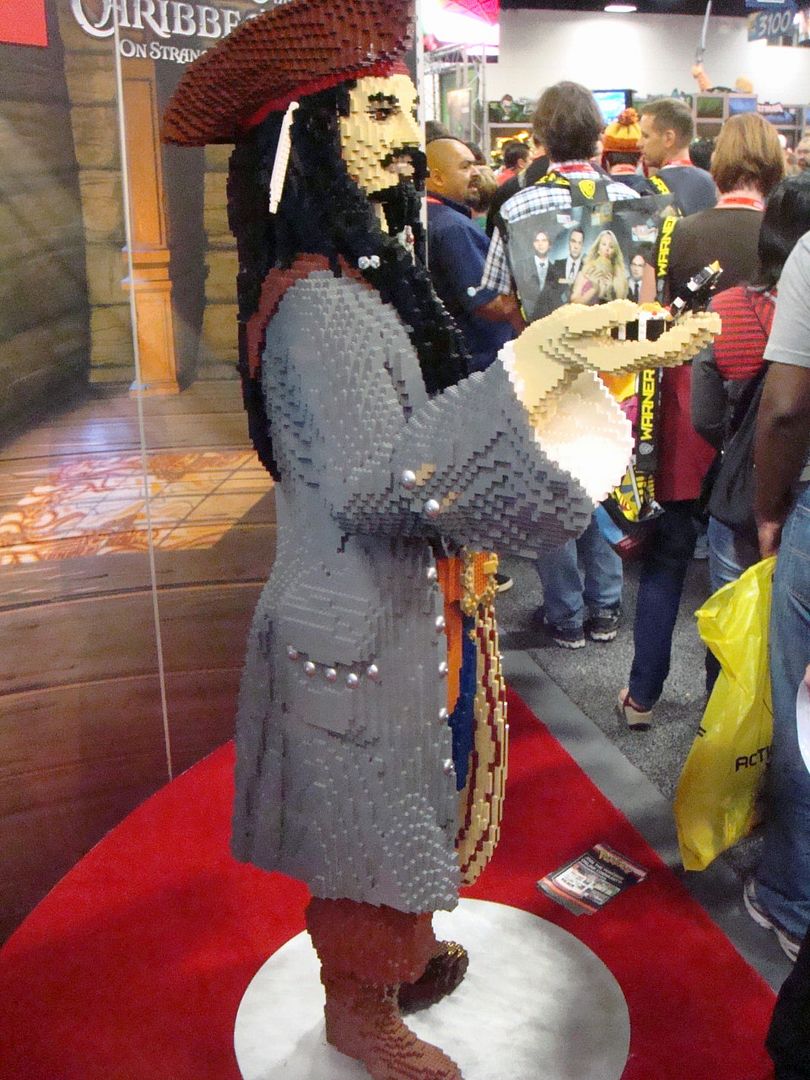
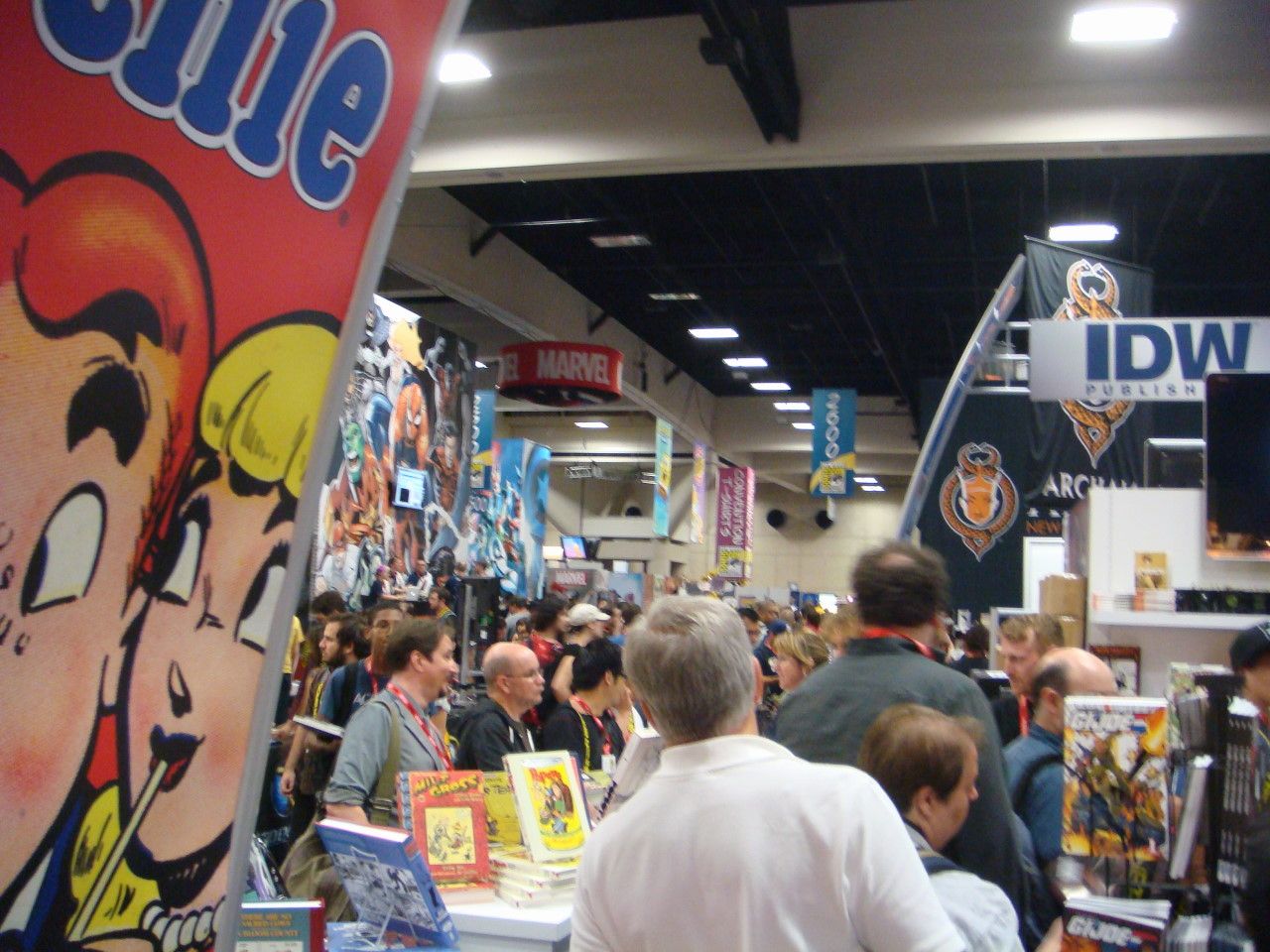

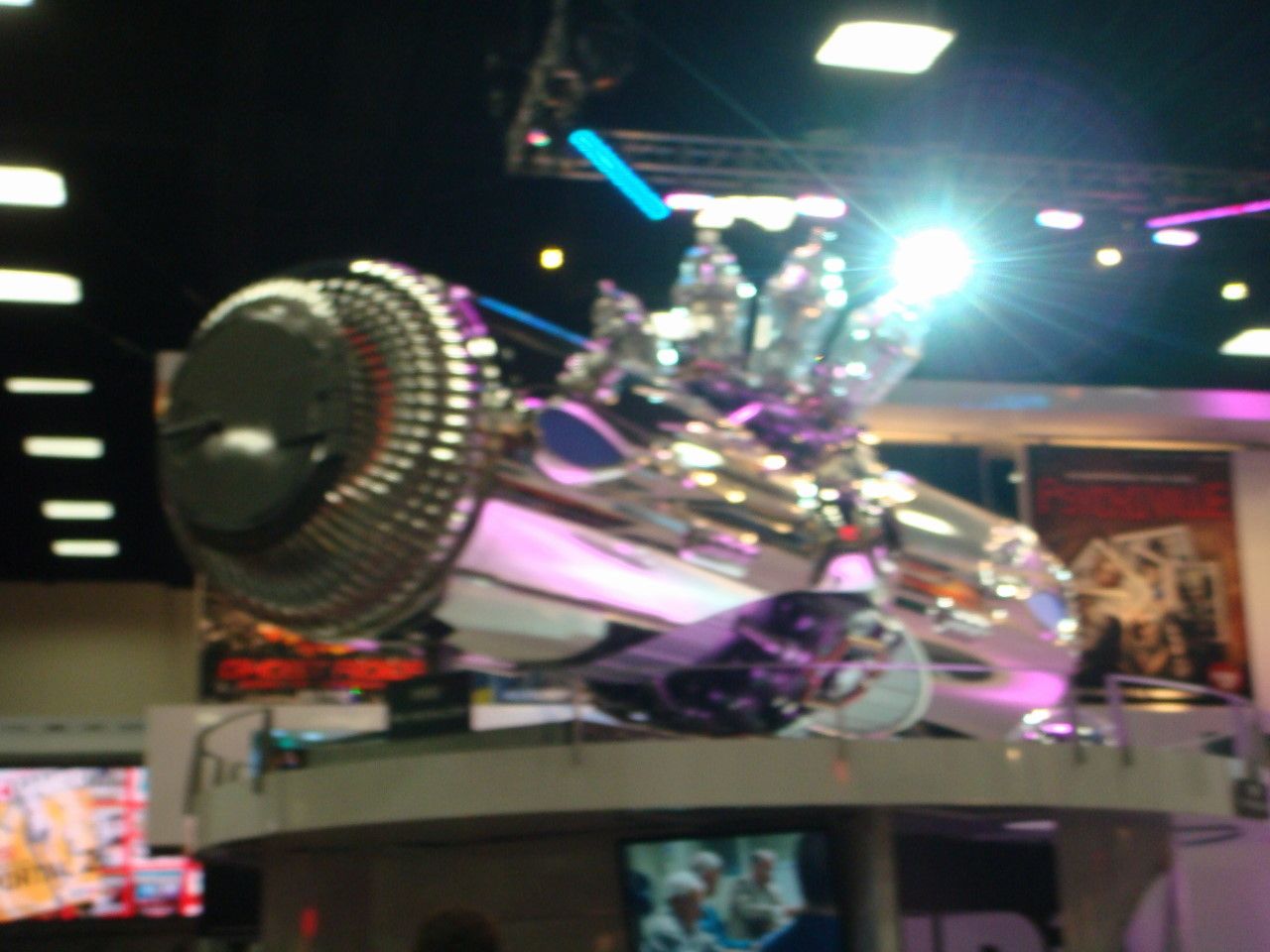
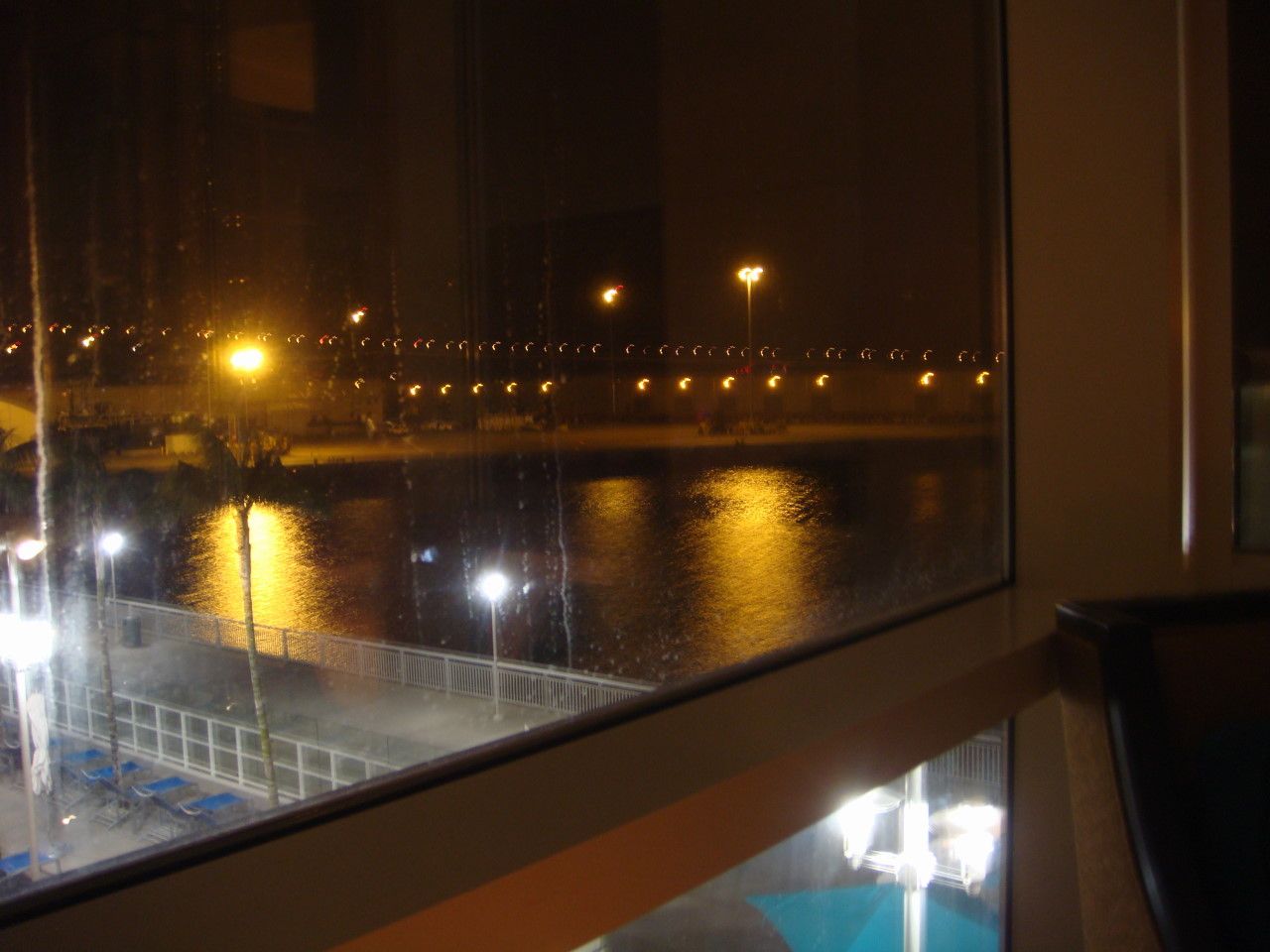
Thursday, July 21, 2011
Comic-Con Preview Night
We managed to get to Comic-Con Wednesday in time to enjoy a full preview night -- which, although limited to those who got 4-day passes plus the preview night (i.e., those who pre-reg'ed at last year's con) was stuffed to the gills with eager fans spending at a pace that belied the dire economy. Photos at Photobucket.
Thursday: The Captain America movie.
Thursday: The Captain America movie.
Sunday, July 17, 2011
One Last Enchantment
When we watched the first Harry Potter movie in 2001, I concede that I had my doubts that the producers would be able to carry out their plans to adapt all of the planned HP novels, with the original cast. The first film was a big-budget extravaganza; and such productions take huge investments of time and money to produce. While the first film did extremely well at the box office, there was no guarantee that future films would duplicate its success (indeed, several of the movies earned less than the opening one, despite rising ticket prices), or that interest in the books and movies would continue to support film projects. Most of all, there was the challenge of the cast. Children grow up, and even when watching a fantasy film an audience would find it hard to accept a 30-year-old as a boy wizard. Moreover, a good child actor isn't necessarily a good adult actor. And children who act in films often put away such childish things as adults, and drop out of acting. The producers therefore had to craft seven (or, as it turns out, eight) high-budget, high-spectacle movies within a short enough time frame that they wouldn't lose their leads.
The films that have tried to duplicate the HP formula in the last several years have shown that this is no easy task. Numerous movies based on successful young adult series, such as the Lemony Snicket books or Phillip Pullman's series -- did not progress past the first film. Even the Narnia movie series, which met generally favorable reactions at the box office (especially the first movie), switched distributors, and may not make it past the third film.
Yet the HP producers pulled it off. Doing so took vast amounts of money (although the movies and related merchandise produced mountains of cash in return), multiple directors, and a cast that managed to grow into its roles. But the second part of THE DEATHLY HALLOWS opened this weekend, to spectacular box office (preliminary estimates are that the opening weekend generated nearly $350 million worldwide)and glowing reviews.
And, in fact, the final movie is one of the best. Although it would be impenetrable to a new viewer (or anyone who didn't see the first part), the movie is both a slam-bang action epic, stuffed with spectacular set pieces, and an emotionally-satisfying end to the series. The filmmakers did this not only by dividing the final novel adaptation into two parts (letting the story breath) but finding the dividing line in tone between the sections of the novel and sending the second film on a headlong trajectory that doesn't let up until the final denouement. Further, while retaining the most important beats of the story -- which, like most of the Potter novels, is essentially a game-like quest for puzzle pieces -- the filmmakers reworked scenes to make them more cinematic. In particular, the scene in which (spoiler) Harry and a weakened Voldemort finally go wando-a-wando is not the chatfest it is in the book. Instead, it is a headlong fight that calls to mind the climactic castle swordfights of swashbucklers from Hollywood past.
The result is unprecedented. The closest analogue may be the James Bond film series -- but that series survived only by changing casts and tone constantly; and it did not deal with the quandary of child actors.
So, what now? I don't know if J.K. Rowling will succumb to what no doubt is enormous pressure to turn out further adventures (perhaps some novels about (spoiler) those rambunctious Potter and Weasley cousins and their misadventures at Hogwarts); but even if she doesn't, I doubt this is the final adaptation of this world. Past works of British fantasy, such as the Lord of The Rings trilogy and those Narnia books, have been adapted into multiple live-action and animated versions, not to mention radio dramas. I wouldn't be surprised to someday see a BBC TV series faithfully adapting the novels, with a new cast; or a series of graphic novels illustrating the adventures in slavish detail.
In any event, we have seven books and eight movies (not to mention various ancillary works Rowling has written up) and unprecedented success in translating a young adult series to film.
The films that have tried to duplicate the HP formula in the last several years have shown that this is no easy task. Numerous movies based on successful young adult series, such as the Lemony Snicket books or Phillip Pullman's series -- did not progress past the first film. Even the Narnia movie series, which met generally favorable reactions at the box office (especially the first movie), switched distributors, and may not make it past the third film.
Yet the HP producers pulled it off. Doing so took vast amounts of money (although the movies and related merchandise produced mountains of cash in return), multiple directors, and a cast that managed to grow into its roles. But the second part of THE DEATHLY HALLOWS opened this weekend, to spectacular box office (preliminary estimates are that the opening weekend generated nearly $350 million worldwide)and glowing reviews.
And, in fact, the final movie is one of the best. Although it would be impenetrable to a new viewer (or anyone who didn't see the first part), the movie is both a slam-bang action epic, stuffed with spectacular set pieces, and an emotionally-satisfying end to the series. The filmmakers did this not only by dividing the final novel adaptation into two parts (letting the story breath) but finding the dividing line in tone between the sections of the novel and sending the second film on a headlong trajectory that doesn't let up until the final denouement. Further, while retaining the most important beats of the story -- which, like most of the Potter novels, is essentially a game-like quest for puzzle pieces -- the filmmakers reworked scenes to make them more cinematic. In particular, the scene in which (spoiler) Harry and a weakened Voldemort finally go wando-a-wando is not the chatfest it is in the book. Instead, it is a headlong fight that calls to mind the climactic castle swordfights of swashbucklers from Hollywood past.
The result is unprecedented. The closest analogue may be the James Bond film series -- but that series survived only by changing casts and tone constantly; and it did not deal with the quandary of child actors.
So, what now? I don't know if J.K. Rowling will succumb to what no doubt is enormous pressure to turn out further adventures (perhaps some novels about (spoiler) those rambunctious Potter and Weasley cousins and their misadventures at Hogwarts); but even if she doesn't, I doubt this is the final adaptation of this world. Past works of British fantasy, such as the Lord of The Rings trilogy and those Narnia books, have been adapted into multiple live-action and animated versions, not to mention radio dramas. I wouldn't be surprised to someday see a BBC TV series faithfully adapting the novels, with a new cast; or a series of graphic novels illustrating the adventures in slavish detail.
In any event, we have seven books and eight movies (not to mention various ancillary works Rowling has written up) and unprecedented success in translating a young adult series to film.
Saturday, July 09, 2011
AX 2011: Virtual Girls and Rare Dubs
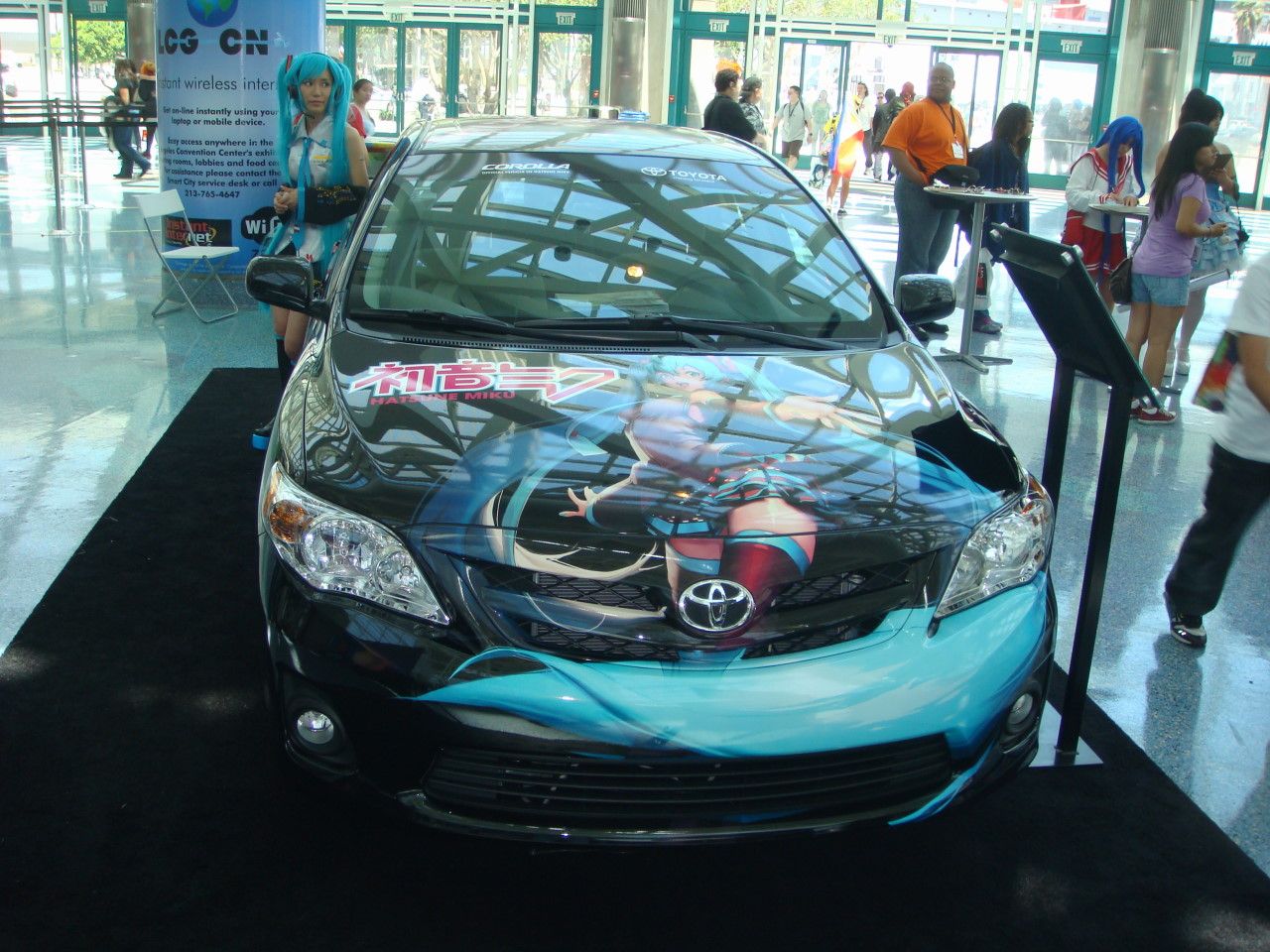
Fans of 1980's-era Japanese animation may recall the 1985 anime MEGAZONE 23, in which Eve, young female pop idol in 1980's Tokyo, turns out to be (spoiler) a holographic projection -- the manifestation of the artificial intelligence that runs a generation ship mocked up to look like 1980's Tokyo.
Attendees of this year's Anime Expo, held last weekend at the Los Angeles Convention Center, could not help but be reminded of Eve as they beheld the face of this year's AX: Hatsune Miku.

Ms. Hatsune, you see, is a virtual pop idol -- a character in the Japanese Vocaloid software, which allows songwriters to hear their songs sung by sythesized voices. With Hatsune Miku, the creators of the Vocaloids (who were guests at the convention) went a step further: They created a live stage show, in which an on-stage band accompanies a holographic Hatsune Miku as she sings, dances, and chats with the audience. This stage show, hitherto shown only in Japan, was brought to the Nokia Theater (next to the Convention Center) on July 2, 2011; and the buzz about the concert dominated the convention, particularly since folks appeared to fly in from all over the world to see the concert. Throngs of cosplayers dressed as Miku and her fellow Vocaloids; and Toyota, which had picked Hatsune Miku as its virtual spokesidol, parked Toyota Carollas, emblazoned with images of the aqua-haired youth, in the front lobby of the convention center.
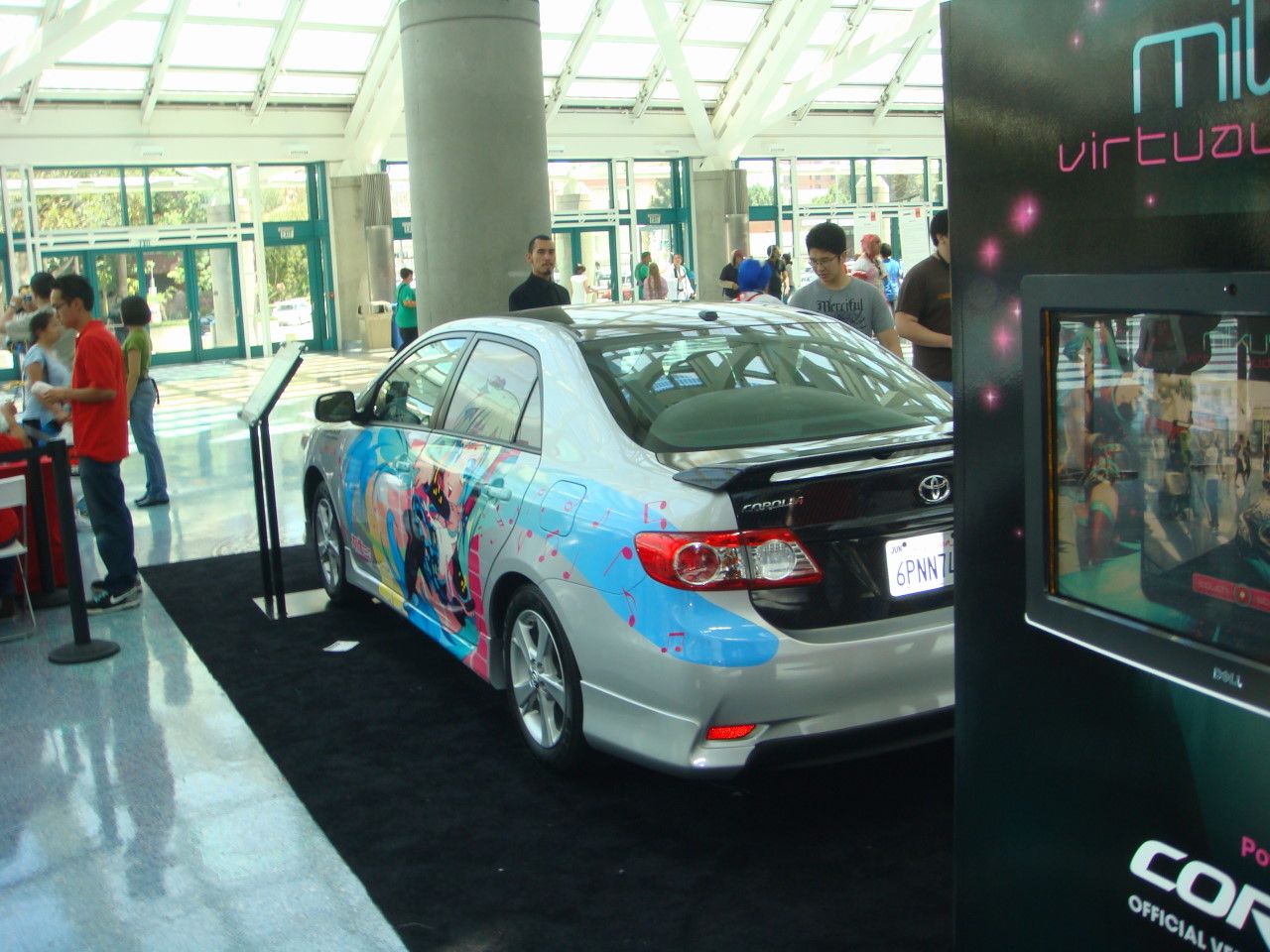
Of course, there was more to AX 2011 than virtual pop idols. I've never seen statistics, but I'd bet that AX 2011 has one of the highest concentration of costumed attendees (and of high-quality costumes) of any of North America's various anime, comic book, and science fiction conventions. This AX was no exception; the hallways were thronged with impressive costumes.

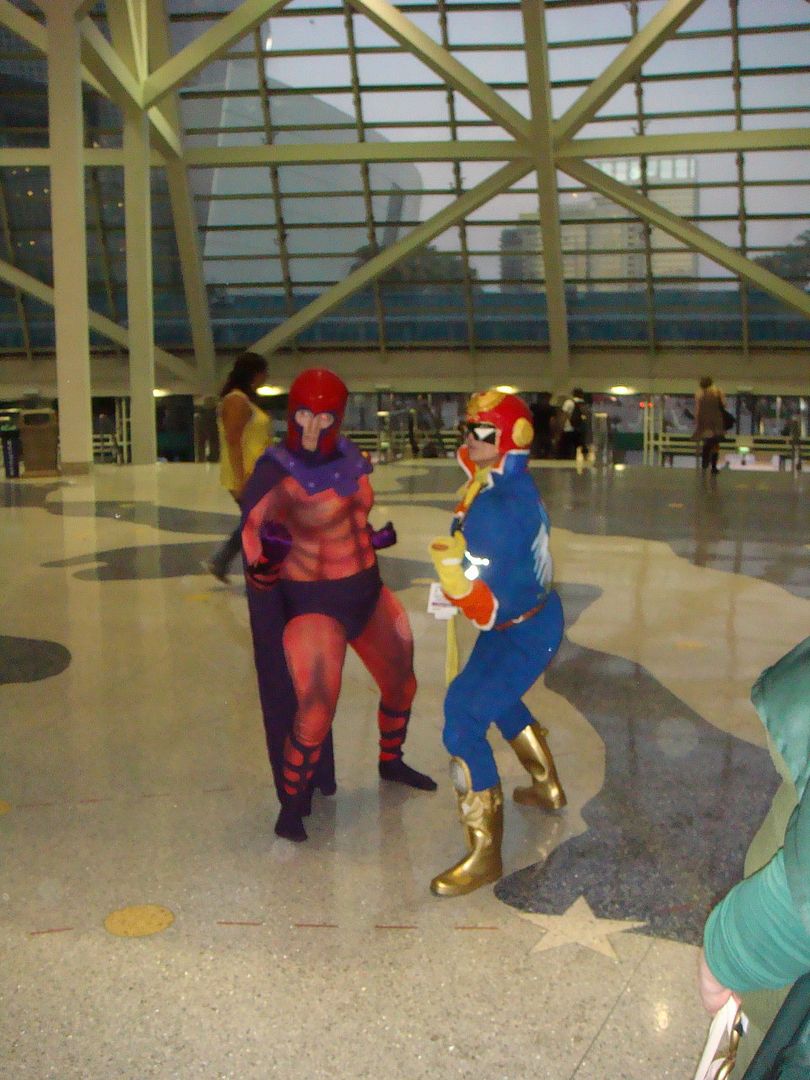
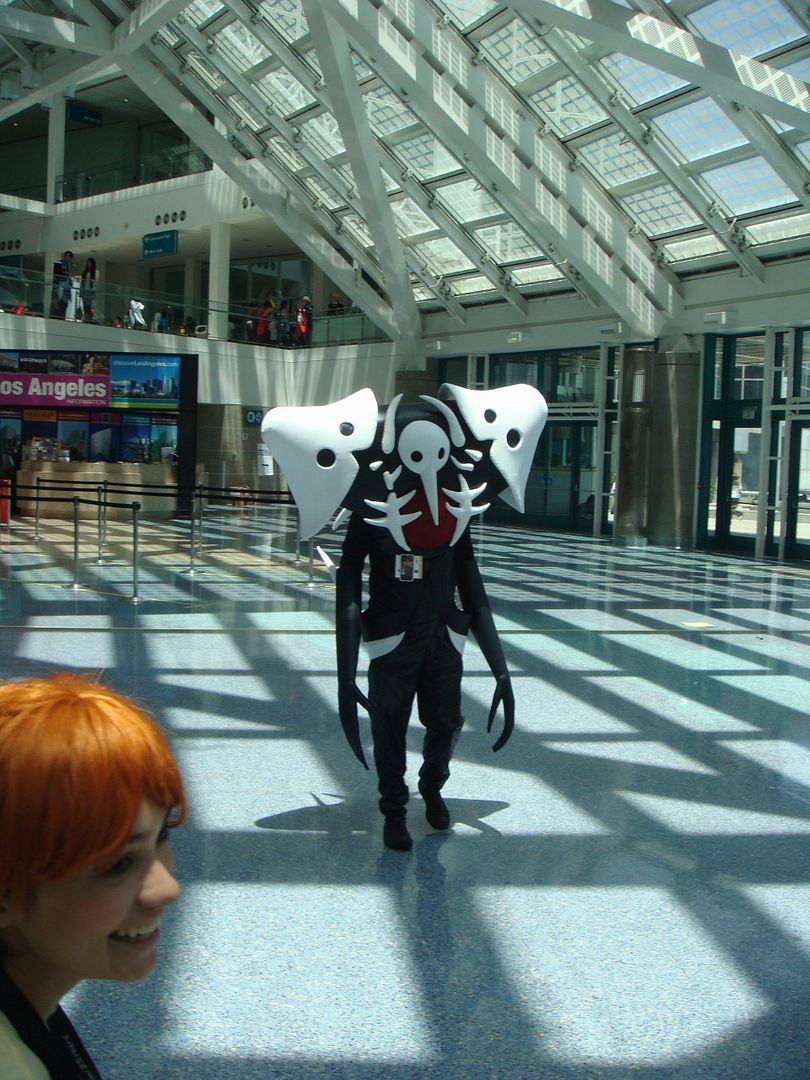
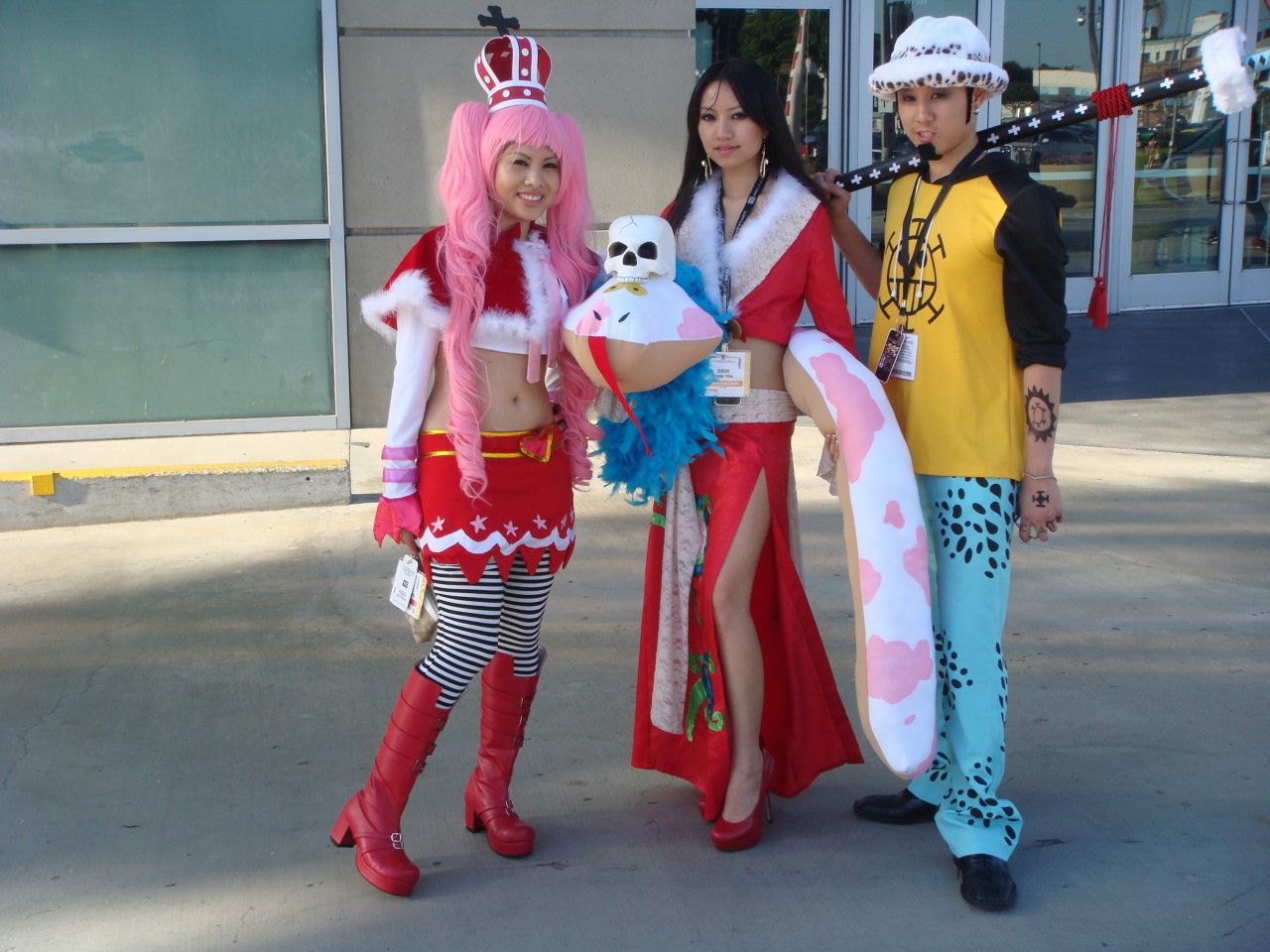
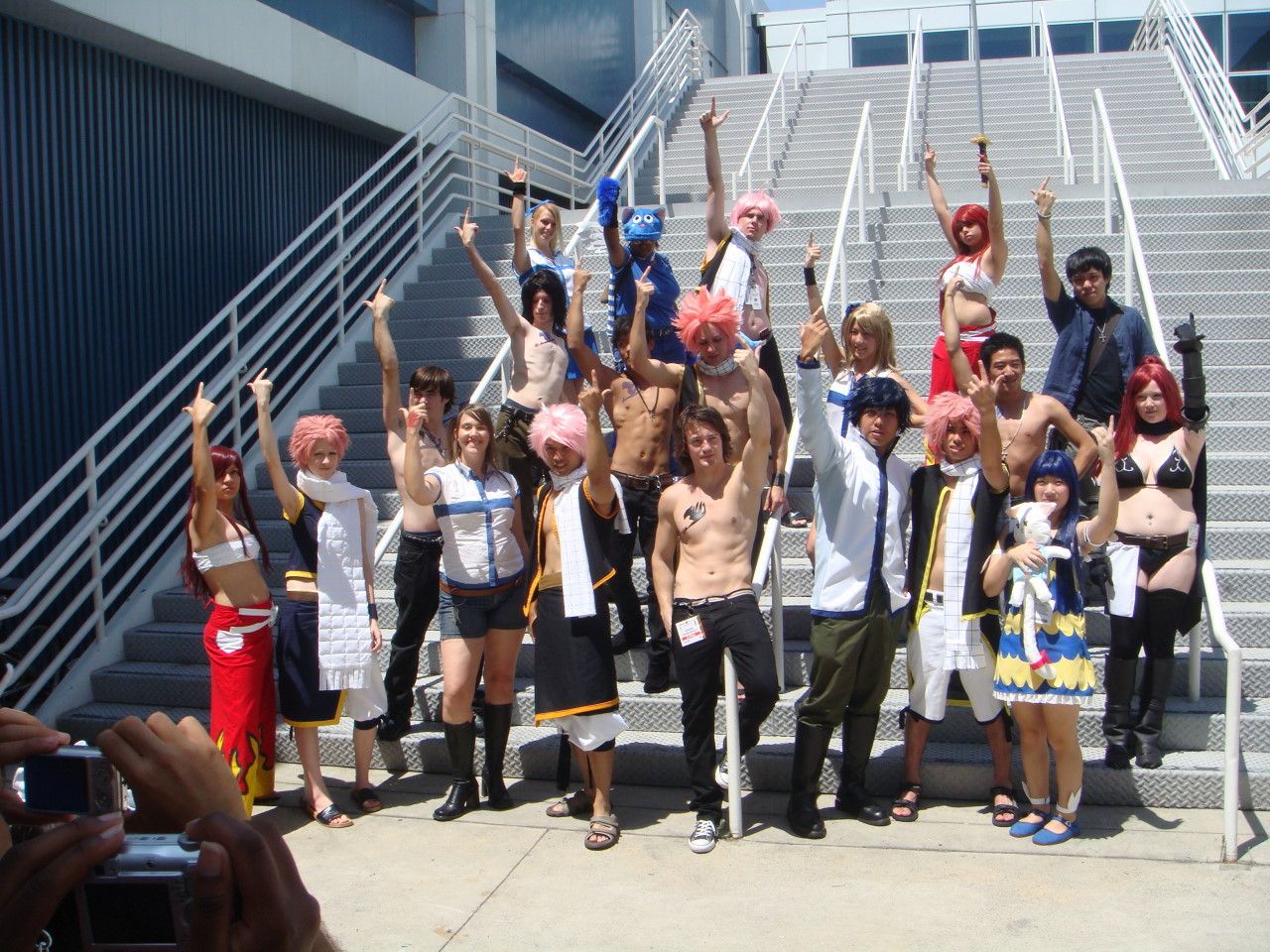
The attendance at AX was impressive, in light of the current U.S. licensed anime and manga industry. That industry has been in the doldrums in the last few years, as the bubble burst in the market for these products (due to, among other things, the crashing economy, the failure of the Musicland and Borders chains, and the lack of standout shows and manga titles). Indeed, for a couple of years, almost no new anime DVDs were produced. At present, only a few licensors are left out of what was once a crowded field; and only a few anime titles go through the expensive process of dubbing -- many are licensed only for the much less expensive Internet-streaming, subtitled market.
To make matters worse, licensing issues (including Japanese right-holding companies changing hands) have complicated the distribution of existing titles. In particular, although four translated editions of the HELLSING ULTIMATE DVD series have been released in the U.S., no new ones have come out here in the last two years (although the series has continued in Japan) due to contract issues. As a result, there were fewer cosplayers in Hellsing costumes this year; although previous AXs featured two or more Hellsing costume photoshoots, this one had none.
Also creating problems for the convention were a new anime con, AM2, which the founders (former AX staff) chose to put on during the same weekend as AX, and in the same venue where AX used to be held, in a possible attempt to hurt AX's attendance. (Didn't work, although folks we'd often see at AX spent the weekend at the other convention.)
Nevertheless, the attendance topped 47,000, which is huge by any standards; and the attendees had tremendous fun. Further, there were signs that a leaner anime licensing industry was pulling itself out of its sinkhole, with new licensing and dubbing projects. In particular, Bandai premiered a dubbed version of THE DISAPPEARANCE OF HARUHI SUZUMIYA, a feature-length coda to the two TV series adapting the light novels of a manic-depressive high school girl who unknowingly has the power to warp reality. (The two-hour, forty-minute feature is a tour de force for voice actor Crispin Freeman, who delivers dialogue or narration in every scene.)
And Funimation, which has emerged from the licensing miasma as the dominant company, held a raucous panel for its dub of the 2010 hit anime series DURARARA.
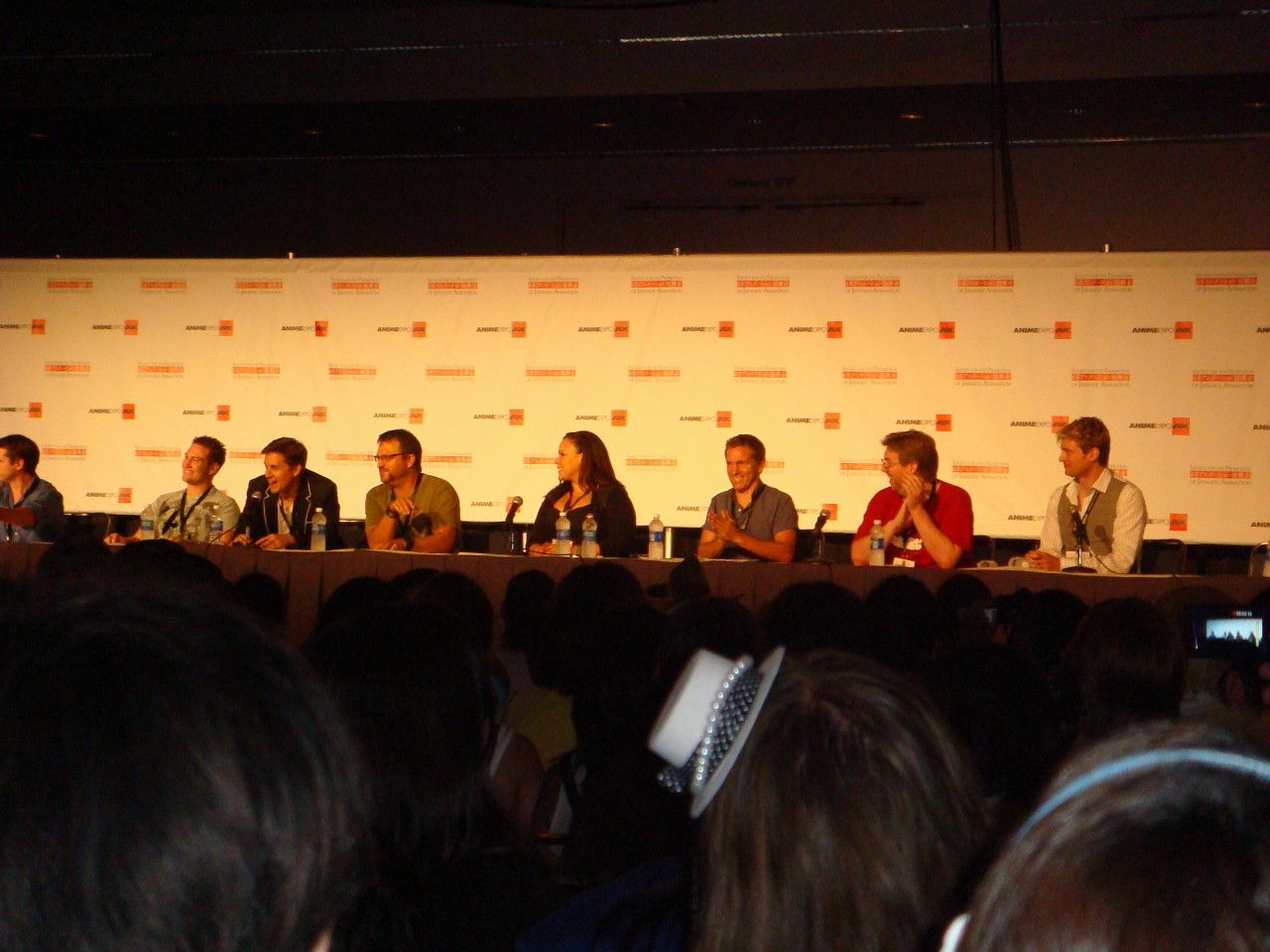
The success of the DURARARA DVDs is even more impressive because the entire series was made available to fans in 2010 (and is still available) for free, in subtitled form, on Crunchyroll.com. Yet the dubbed version has prospered, and is now showing on Adult Swim.
The events we attended included the Midnight Tea, in which fans created tea party settings based on anime and similar characters. The settings showed off the artistry and sense of fun typical of AX costumers.
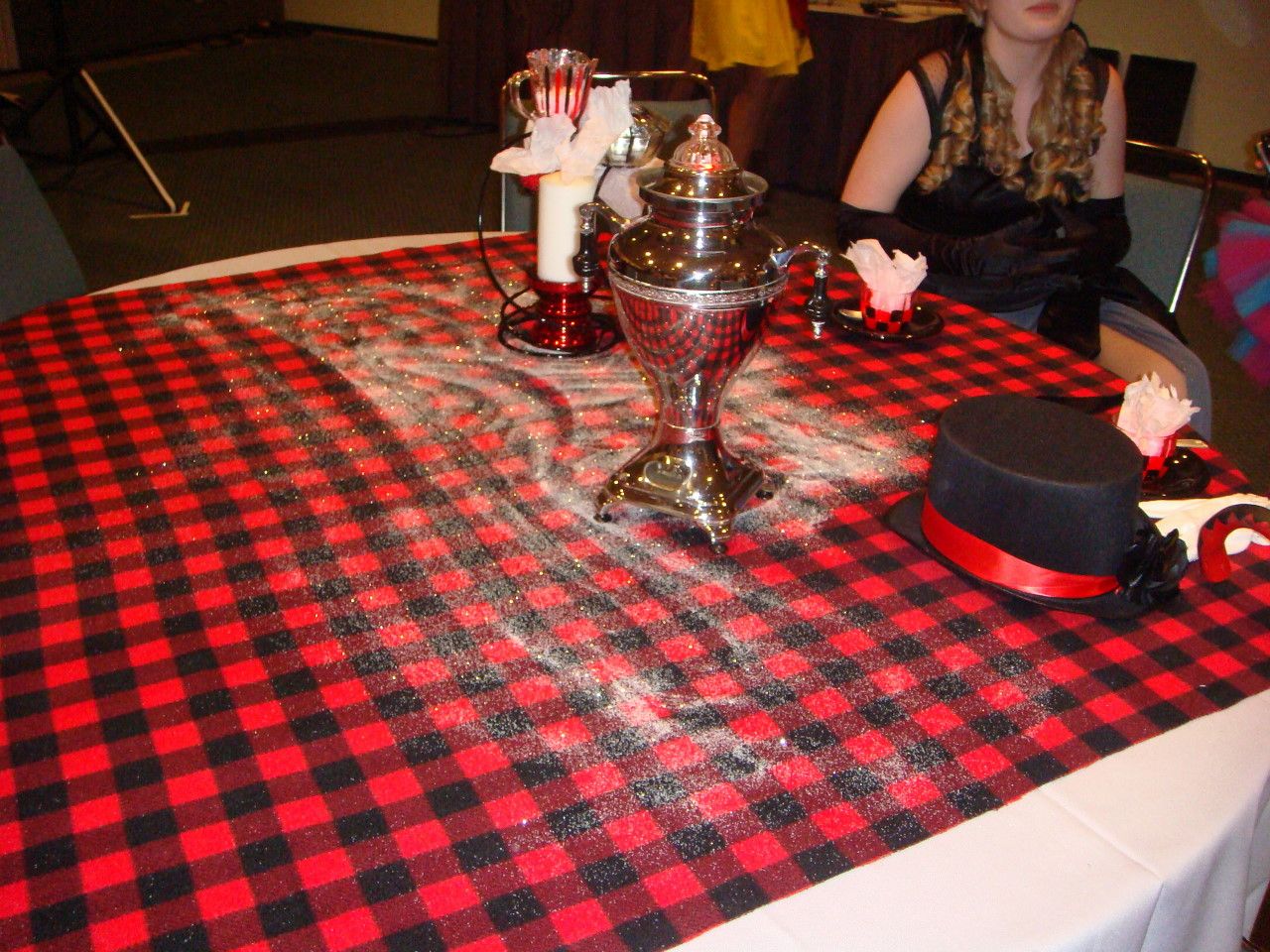

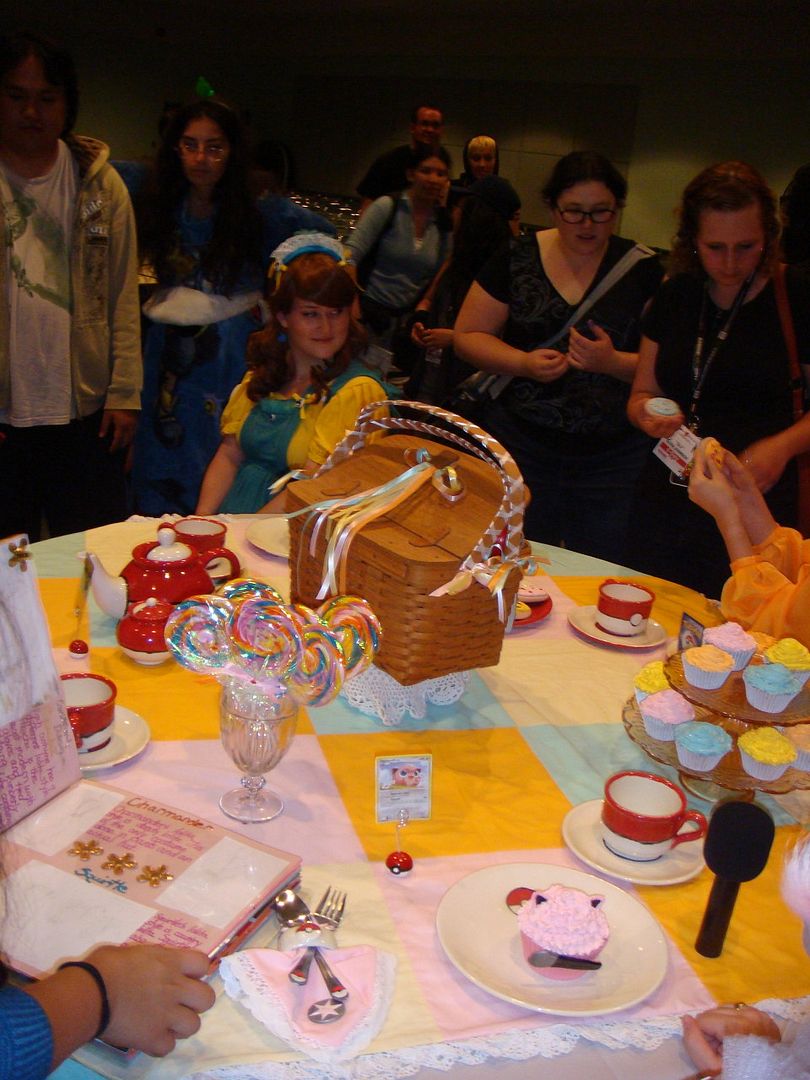
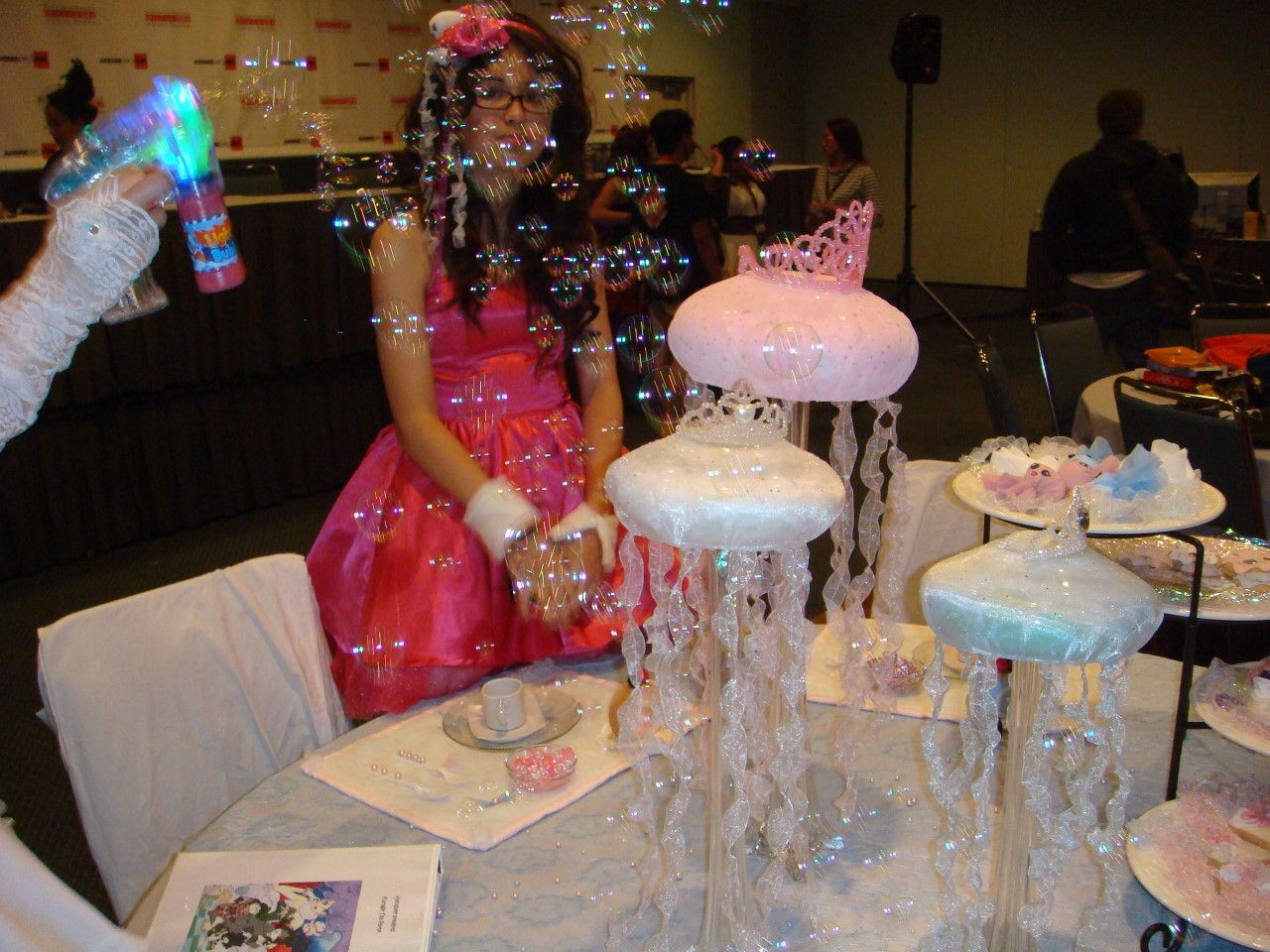

On Saturday, we attended the Hatsune Miku concert. The concert was the stuff of science fiction. The holographic singer, a huge glass screen behind her, was an amazing illusion: From a distance she looked like a human being, sharing a stage with the (excellent) live band backing her up; but a closer look revealed that she was indeed an anime character, with huge eyes, a tiny mouth, a bare hint of a nose, and an inhumanly streamlined body. Further, while she was occasionally raised and lowered onto the stage as if on a trapdoor lift, she was not limited to mimicking reality. Sometimes she changed costumes and hairstyles onstage, in the blink of an eye; sometimes she transformed into a ball of light, and shot around the stage, glowing stars in her wake, until she emerged in a different outfit. And while her voice seemed human (albeit autotuned, like so many current human singers), she would also sing some songs with inhuman speed and precision. Some of her fellow Vocaloid singers took their turns on the stage, sometimes in duet with Miku. The capacity crowd ate it up, dancing and waving glowsticks in time with their laser-light heroine.
http://www.laweekly.com/slideshow/anime-expo-at-night-hatsune-miku-in-concert-tune-in-tokyo-at-club-nokia-33682720/3/
For us, one of the highlights of every AX has been the Meet the Guests reception, at which the attendees (for a premium ticket) get to meet tha Japanese and American guests one-on-one. This one, however, may be our last. The price per ticket has skyrocketed (from $20 at our first one to $75 for this one); the time for the event was shortened (it was supposed to be held from 6 pm to 7:30, but folks were not allowed in until after 6:30); the venue was so loud that the Japanese guests complained; and while an impressive food spread was provided, the only liquid available was via a cash bar. Further, attendees were limited to five minutes with each guest before having to move on to the next. Despite these detriments, the guests themselves were delightful. Highlights included the folks behind the aforementioned Vocaloids; the production staff of LAST EXILE, the 2003 dieselpunk tv series that is being continued this year; voice actor Toshio Furukawa, whose career has stretched from MOBILE SUIT GUNDAM in the 1970s to his portrayal of Ace in the current hit series ONE PIECE; and ace American voice actor/director Taliesin Jaffe.
With all of its flaws, AX remains the place to see fantastic costumes, guests from Japan, and tens of thousands of enthusiastic fans.
Subscribe to:
Comments (Atom)